INVITATION – FRIDAY 2ND DECEMBER


Pete Lowden is a member of the Friends of Hull General Cemetery committee which is committed to reclaiming the cemetery and returning it back to a community resource.


Pete Lowden is a member of the Friends of Hull General Cemetery committee which is committed to reclaiming the cemetery and returning it back to a community resource.
Another year over. At least in terms of Heritage Open Days and Hull General Cemetery. It was its usual success. Approximately 50 people turned up over the two Saturdays which is a very good response. It’s down on last year when it was over 100 but I think that year was partly a response to lockdowns and people wanting to get out into the fresh air. We were also blessed with good weather for the last two years which is always a bonus on an outdoor gig.
It is still the most popular of guided walks. Indeed I have been told that it is the most popular attraction of the entire HODS week. That’s pretty cool for a derelict cemetery. The initial aim of the Friends was always to raise the profile of the site and I think that we may have achieved this to some extent.
However the other major aim, such as returning it to a viable, well maintained community resource, is still ongoing. It will probably need a lot more effort from the Council and the wider community to assist the Friends to achieve that goal. Let’s just say it’s a work in progress.
As for Heritage Open Days I’m afraid that is it for the time being for guided walks around the site. I’m taking a year out as I have a lot of other projects which desperately need work on. So I have taken the decision not to undertake any guided walks next year for the Heritage Open Days. This includes the Western Cemetery one too. I will probably come back in 2024 but right now 2023 is earmarked for other things.
Having said that, I don’t have the monopoly on giving the guided walks. I’m quite happy for that mantle to be passed on to others. Permanently if they like the job. So, if you are up to giving it a go, feel free to contact me and I’ll give you as much help as I can.

Pete Lowden is a member of the Friends of Hull General Cemetery committee which is committed to reclaiming the cemetery and returning it back to a community resource.
There’s a new book. It’s called The Life of Hull General Cemetery Lodge and Other Stories.
The book covers the story of how the Cemetery Lodge, the jewel in the crown for the cemetery, was created but also the sad story of its loss to the forces of ‘progress’ in the 20th century. This building, the first commission of the noted Hull architect, Cuthbert Brodrick, was a creation in the Victorian Gothic mode. Its fairy tale castle effect was a highlight of the town. Yet within a a lifetime it was swept away.
Other stories in the book cover the struggle to create the Cemetery; the story of how the destruction of most of the headstones during the development of the cemetery in the 1970s took place and finally, a revisiting of a celebrated walk around the Cemetery by John Symons in the 1880s.
It’s available at Amazon and is priced at £10 post free.
The other books in this series are also still available from Amazon. These are a Short History of Hull General Cemetery, priced at £7. The War Dead of the Cemetery, priced at £10. Public Graves, Workhouse Graves, Catacombs and Crosses, priced at £7 and finally A Short History of Burial in Kingston Upon Hull from the Medieval Period to the Late Victorian Period. This is also priced at £7.
With the nights drawing in, what better way to spend them by reading about cemeteries and death. Go on, treat yourself for Halloween. At the worst you can always burn them to keep warm.


Pete Lowden is a member of the Friends of Hull General Cemetery committee which is committed to reclaiming the cemetery and returning it back to a community resource.
This month’s anniversary is related to the railway that once ran past its gates.
On the 2nd September 1852 the Board received an engineer’s report. This engineer was employed by the York and Midland railway Company. This report detailed a new layout for the proposed branch line to the Victoria Dock. It was the culmination of a campaign waged by the Company to get the railway company to change its mind. And it was a success. Let’s go back a bit and see how this situation came about.
Back in December 1851 the Board received an unexpected and definitely unwanted Christmas present. C.S Todd, the secretary reported that,
‘plans and sections of the proposed Victoria Dock Railway had been lodged with the clerk of the peace for the borough of Kingston upon Hull on Saturday evening and that the proposed railway was projected to pass between the north west corner of the late waterworks and the gates of the Cemetery at a distance of comparatively a few feet and requested instructions as to the course under such circumstances.’
Obviously this development caused consternation with the Board. They knew that a branch rail line was in development but they had no idea it would impinge upon the cemetery. That it would run a ‘few feet’ from the entrance would be disastrous for the cemetery. The effect it would have upon the Lodge was also something that had to be taken into consideration. The Board knew it had to do something quickly.
‘It was resolved that a deputation consisting of the chairman, Mr Irving, and Mr Todd do wait upon the Directors of the York and North Midland Railway Company upon the subject of the injury to the cemetery in consequence of the above railway and that in the meantime the solicitor do see the plans lodged and get all the requisite information upon the subject.’
The meeting with the Railway Company was soon forthcoming. The meeting took place on the 14th January 1852. To say it wasn’t a success would be putting it mildly. The Railway Company saw no reason to change their plans. If it caused the Cemetery Company problems , well that was no concern of theirs.
The Company employed their own engineer, Mr Clarke, to draw up alternative plans for the route of the railway line. The Board also thought that an extraordinary meeting of the shareholders should be called to inform the proprietor’s of this situation.
This meeting took place on the 20th February.
‘The chairman opened the proceedings by stating succinctly to the meeting what had already been done by the directors respecting the proposed crossing of the railway Company immediately in front of the cemetery’.
He then called upon the secretary to read out the correspondence between the Railway Company and themselves. Sadly none of this survives but the Secretary, in the minute book, does state,
‘that he had received from the directors of the Railway co., a letter by no means satisfactory inasmuch as it bound the company to no fixed mode of arrangement’.
Oh, the wealth of meaning behind his clipped legal words.
The feeling of the meeting was pretty high at this point and the proprietors made their views quite clearly to the Board and the meeting,
‘fully authorised and empowered (the Board) to take such steps for the protection of the Company’s interests in the matter of the railway crossing as they may be advised and deem right and that if necessary they be authorised to proceed to parliament for the purpose of attaining that object.’
This was the nuclear option and the Railway Company probably did not see it coming. The issue was raised with the standing committee of transport and by May a resolution was forthcoming. The Railway Company accepted the plans as put forward by the Cemetery Company,
‘and that the railway Company had agreed to pay this company £2500 on condition that certain suggested alterations should be made at the entrance of the cemetery.’
So, a victory for the Cemetery Company. Well, not quite. Firstly the railway line was still to run quite close to the front of the Cemetery. Secondly, what were these ‘alterations’ mentioned?
An insight into these was noted in July. The minute books state that ‘extra gate piers’ were needed at the front of the Cemetery. Where and how they would fit into the original scheme is difficult for us now to visualise. The Board empowered John Shields, the superintendent, to,
‘be authorised to purchase the necessary stone requisite for the extra gate piers and also obtain an estimate of the difference of expense to the company between our having gates across the whole of the new entrance or only palisading with a dwarf wall for two openings, both in the present and projected entrance and in the event of the latter plan being adopted then the cost of removing from the present to the new entrance two sets of the gates now at the former and that in the meantime the new walk required for a cab stand to be laid out, planted and completed forthwith.’
So, these were the alterations that needed to be carried out. As I mentioned visualising the changes is difficult as the only image we have before the railway was laid out is from Bevan’s lithograph which is an artist’s impression.
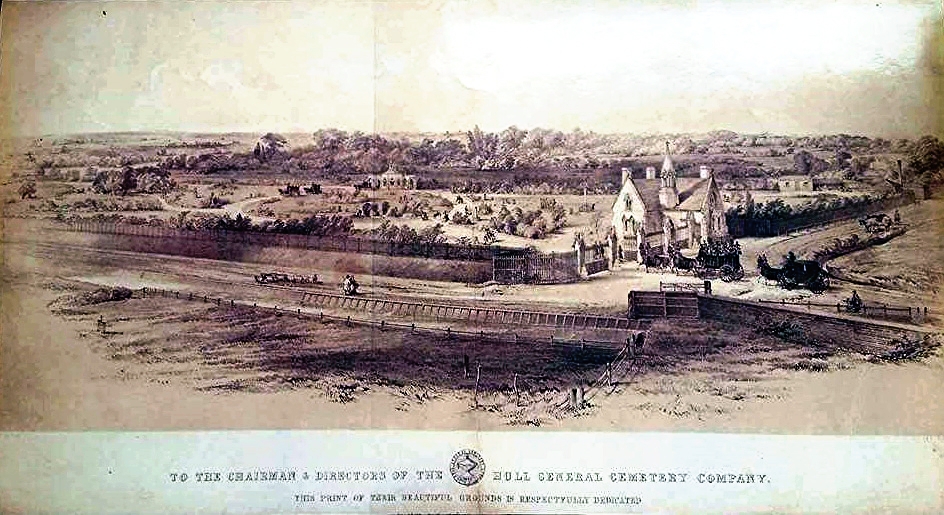
The lithograph shows both the lodge and the chapel built with gates. This is wrong as none of those buildings were built at the time of the lithograph being printed. There would have been some gates at the entrance but what they were like is open to question. In other words we are quite in the dark about these ‘alterations’. Suffice to say that they took place.
On the 26th August, a visit took place from Mr Carberry. This was the engineer from the Railway Company. He fully approved of all what the Cemetery Company had done. But there was a sting in his tail for he went on to show the detailed plans he had brought with him.
‘Mr Carbery then laid before the Board the plan and sections for the Gatekeeper’s house, as proposed to be erected by the Railway Company, and the same having been examined by the Board, and it appearing to be the intention of the Railway Company to erect such house in front of the entrance lodge of the Cemetery.
It was determined to make an offer to the Railway Company to build them a gatekeeper’s house on the ground of the Cemetery and corresponding in style and architecture with the Cemetery lodge, on receiving from the railway Company £100 the amount intended to be expended by them, the additional expense to be borne by this company and that in the event of such an offer being accepted another house should be built on the other side of the lodge in uniformity with the gatekeeper’s house and Mr Carbery stated that he would lay such an offer before the Railway Directors and recommend that the same should be carried out as proposed.’
The Cemetery Board must have been horrified by the idea that a workmen’s hut should be placed in front of the Lodge. But they knew that they could not resist this insult. That is, unless they upped the ante. This they did by saying that they would build the gatekeeper a house on their land to the west of the Lodge, in the style of the Lodge. This was agreeable to the Railway Company and the gatekeeper of the level crossing for Botanic Gardens Station lived there until its demolition in 1907. That the Cemetery Company then felt the need to add ‘balance’ to their frontage and erect another cottage to the east of the Lodge was simply just showing off. It was used to house the foreman of the Cemetery staff which at this time was a man called George Ingleby. He remained there until the 1890s.
These cottages were not built to the standard of the Lodge. Simpson and Malone, quality builders and stonemasons, wee employed to construct them. As the bill tendered for payment indicates, the cost for building both cottages was £170 each. The lodge cost much more than that. Still one had to keep up appearances. The final bill for the cottages came to £320 when other aspects were taken into account. The Company probably thought it had done well getting 320 knocked off the price.
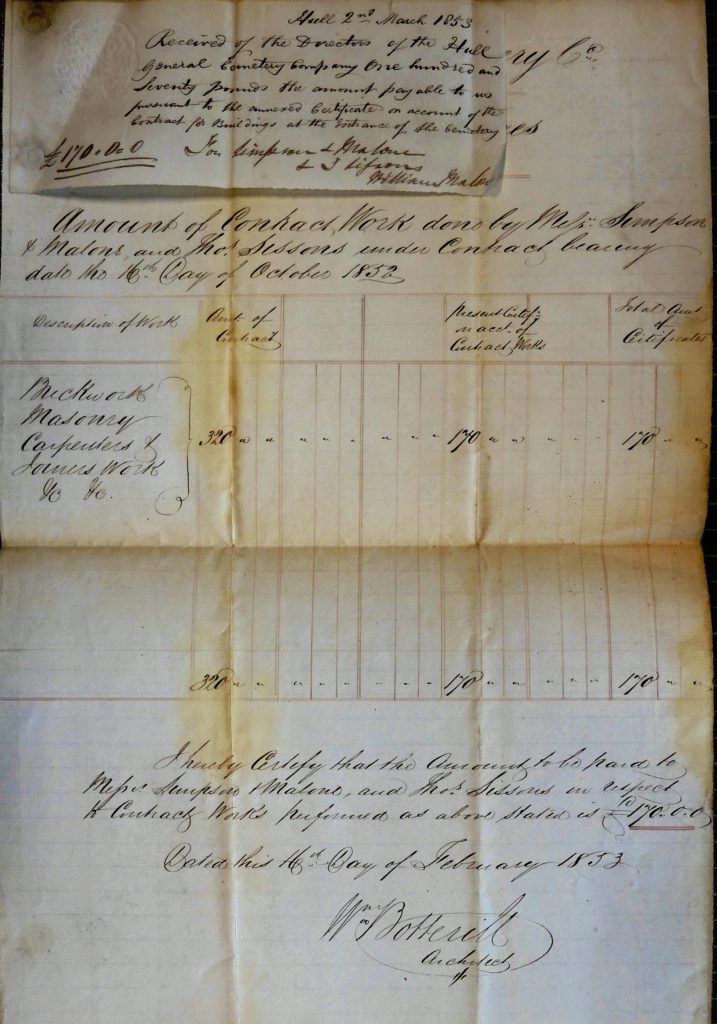
And so we come to that date in September 1852. The anniversary of the coming of the railway to the Cemetery. At the meeting,
‘A letter was then read from Mr Gray, the secretary of the York and North Midland Railway Company, accepting the offer made to Mr Carbery as to building the gatekeeper’s house on the Cemetery grounds provided his company would give to the Railway Co. a lease of the house for 21 years and after the expiration of that period agree not to terminate the tenancy unless upon giving 6 months’ notice and repaying the said sum of £100 and the matter having been discussed it was resolved that this Board do approve of such an arrangement and that the secretary be requested to communicate with the Railway co.’s secretary in order to carry out the same.’
And there the matter was resolved.
However, was it worth it? Was the proximity of the railway line to the front of the Cemetery that important? We are not in a position to judge whether the moving of the track bed by a few feet was so vital to the interests of the Cemetery. Obviously the Company thought it was. But was it worth it? Ah, that’s good question, especially knowing how things turned out for the Cemetery.
Firstly we have no idea what the cost was for the erection of the extra gate piers but it was a cost the Company had no need to indulge in at that time. Secondly, we do know how much the erection of the cottages cost and that was £320. Yes, they were a fixed asset and they received rent from them but it was a cost that was unnecessary. Thirdly, parliamentary time does not come cheap and the cost of that was £850 5s 1d. This is a considerable sum. The cost of buying the entire site for the Cemetery was only just over £5000. And then we have the cost of the new gates, ordered from Thompson and Stather for £53 10s.
So, overall a cost of northwards over £1200. The Bank of England inflation estimator reckons this sum would be worth £116,966 today. Now that’s quite a tidy sum to spend because you don’t want to have a railway track next door. Some people might say that about having a Cemetery next door. There’s no accounting for taste.

Pete Lowden is a member of the Friends of Hull General Cemetery committee which is committed to reclaiming the cemetery and returning it back to a community resource.
Yes, I know. I put the month of August last month instead of July for the Anniversary item. Anniversary August 1846
What can I say?
To attempt to make amends here’s another item from the history of the Cemetery commemorating a date in July. I hope I’m forgiven.
On the 2nd of July 1857 the Company Minute Books mentions a first for the Cemetery Company. The installation of a windmill. John Shields, the first superintendent of the Cemetery, reported back to the Board. His report was succinct.
‘Mr Shields produced a plan of the windmill proposed to be erected in the cemetery and the estimate for building same viz – Messrs Thompson and Stather for iron work £25, Messrs W. & D Todd for woodwork £22 and such estimates having been fully considered resolved that such estimates be accepted and that the Mill be forthwith erected.’
So why a windmill? The short answer was that the Company had bought and installed a steam engine in 1846 which had helped with the draining of the site. After this it was then used to help with the stone cutting of the monumental works of the Company. However the Company appeared to have little luck with their engines. Over time they either needed repair, or sometimes replacing all together. As the steam engine would have been the largest capital expenditure after the purchase of the site itself such ongoing costs were constantly eating into the profits of the Company.
The Board were in a quandary about this issue. John Shields thought he had come to a solution. In May of 1857 he recommended to the Board that they should install a windmill to, ‘be used instead of the engine to pump water out’. The Board asked him to get an estimate of the costs this would incur.
And thus we come to the meeting the following month and the Board decided to go ahead with the erection of the windmill after seeing the estimates that Mr Shields placed before them.
The windmill continued to work for the Company for almost the next twenty years so it proved a good investment. It’s final removal was due to the development of the Avenues. In November 1874 the Minute Books state what buildings were to be demolished and re-instated further into the Cemetery by David Garbutt’s Avenues development. These buildings were,
‘the stable building, hearse shed with loose box attached, engine and boiler house and chimney shaft, carriage wash, privy, brick and cart shed, and to take down and reconstruct the engine, boiler, windmill and all gear, pumps, well etc.’
The following month, December 1874, the situation was that,
‘The secretary reported that the company’s fence had been set back and the stables, coach house, cart shed etc pulled down, and he further reported that the engine, windmill and pumping gear had been advertised for sale …. But as yet no satisfactory offer had been made for the same and as Mr Garbutt was pressing for possession of the land upon which the same stood such engine, mill etc had, by the chairman’s orders, been sold by public auction and had realized after paying auctioneer’s charges, advertising etc £27 4s and the purchasers were then removing same.’
So that is the short life of the Cemetery’s windmill. It must have been a grand sight. What is also interesting is that the sale price of the engine, windmill and pumping gear realised less that the original cost of the windmill back in the 1850s. Another instance of the Company’s directors not being very good businessmen.

Pete Lowden is a member of the Friends of Hull General Cemetery committee which is committed to reclaiming the cemetery and returning it back to a community resource.
The month of August is an interesting anniversary.
On the 8th August 1846 the Board of the Cemetery Company had a pleasant surprise. They received a visit from a surprise visitor. That visitor was John Shields, the superintendent of York Cemetery. And this was not simply a courtesy visit. The Company minute book records that,
‘Mr John Shields, the superintendent of York Cemetery, called and laid before the chairman the following testimonials of character and stated that he would be at liberty on the first week of Sept.’
This news was a great, and probably quite a pleasant surprise. Here was an experienced superintendent of an existing cemetery who was offering his services to them. Although there appeared to be no other candidate for the post this may well have been because the Board had not gotten round to advertising for the post. They may well have not even given a thought to it. So this sudden arrival of John Shields must have almost been like manna from heaven.
The Minute book also actually records John Shields testimonial from York Cemetery,
‘York, August 7th 1846. The Board of the York Public Cemetery hereby certify that John Shields, our late manager and gardener has been 9 years in our service and during that time has conducted himself in an honest, sober, industrious and attentive manner and has filled his situation with ability.
Signed Thomas Price, Chairman, York Cemetery.’
On the 26th September the Board did take the proper and correct decision. They offered John the position of general superintendent, registrar and manager at the princely sum of £90 per annum. The Company also offered to pay his rent for his residence until the Lodge was inhabitable.
He remained in this post until his death in December 1866.

Pete Lowden is a member of the Friends of Hull General Cemetery committee which is committed to reclaiming the cemetery and returning it back to a community resource.
The anniversary this month is poignant. It marks 50 years since the Hull General Cemetery Company dissolved itself. Since that time the site has undergone some changes; some good, some not so good. It has changed ownership for better or worse. The site has been ‘developed’ and then allowed to sink back into the ‘decay’ it had been in before that ‘development’. One could say that Hull General Cemetery has had mixed fortunes since the last meeting of the shareholders of the company took place.
But that was in the future. In June 1972 no one knew what would happen to the site, least of all the Company, and neither did its future owners, Hull City Council. At no time did it seem certain that Hull City Council would become the owners. Although, quietly and behind the scenes, some activity told a different story.
Let’s look at how the Council did take over and this story may take us all back a lot further than you’d think.
On the 14th December 1853 the company received a letter from the clerk to the Local Board of Health. This body had recently been set up in response to the Public Health Act of 1848. Amongst its many duties was the control of burials within its district. It was with this duty in mind that Mr Wells, the clerk, wrote to the Company. Mr Wells said that he had been instructed by the Parliamentary Bill Committee to ask the Company to name their price with regard to selling their cemetery.
This letter on the face of it was straightforward. Basically it asked for the company how much they wanted for selling the site. Underlying that letter though was an implied threat. This threat was that the Parliamentary Bill Committee were, at that moment, steering a bill through Parliament that sought to ‘improve’ the town. Part of that improvement was the right of compulsory purchase of the cemetery. That the letter came from this committee rather than the Local Board of Health itself would not have been lost on the Directors.
It also cannot have slipped the Directors’ minds that the Local Board of Health’s solicitor had written to them in November. This November letter was much less friendlier. It stated that,

The threat of the Local Board of Health (LBOH) to compulsorily purchase the cemetery coupled with the oblique threat of erecting gas works in front of the entrance of the cemetery would have been fresh in their minds.
The December letter stated that the LBOH,
‘would be glad to receive from the Company an offer to sell to the local Board of Health for the benefit of the Borough the Hull General Cemetery and all its property rights and interests.’
A reply was requested by the 22nd. The company replied saying that, ‘it was not their present intention of the Company to part with their cemetery.’
The following February 1854 another letter arrived. In this the Parliamentary Bill Committee suggested that three directors should meet three LBOH members with a view to settling this issue. The Company agreed to this and dispatched the Chair, John S. Thompson, William Irving and John Pearson Bell to this meeting.

Suffice to say that both parties attended the meeting with their own agenda. Although there were glimmers of agreement it was not wholly successful for either side. The Company did agree to sell the cemetery to the LBOH but they wanted the LBOH to come up with a price first. However the LBOH did not do this and the matter was not pursued. No doubt the LBOH felt that their Act of Parliament would gain the cemetery for them. They were in for a surprise.
For the Cemetery Company were also pursuing this approach. It became a race which Act would be enacted first.
As such both parties set to with a will to get their respective Acts of Parliament through the next session of Parliament. By 1854 the Corporation had their Hull Improvement Act in place that would have enabled them to purchase the cemetery. However the Company had managed to get their own Act in place. This forestalled any municipal authority from compulsorily purchasing a cemetery established and incorporated by an Act of Parliament. Stalemate. A couple of years later anther approach almost made it over the finish line but was scuppered by greed. You can read about it here. An Anniversary: June 1856
And so this state of affairs continued for the next 120 years.
Having said that, the fortunes of both parties altered significantly over time. In 1854 the Company was definitely in the driving seat. In effect it could name the conditions upon which it would sell. This was its highwater point. After this the pendulum swung the other way. By the turn of the 20th century the company would have been glad to sell the cemetery but the Corporation now had its own burial grounds and was content to wait.
By the middle of the 20th century the chair, Arthur J. Downs, a relative of Rose, Downs and Thompson, the engineering firm, was reporting to the Company AGM that negotiations to sell the site to the Corporation were stalling.
‘It was noted that the corporation were insistent that steps be taken to recall capital as a condition to their considering the matter further. As such the matter was not competent business for discussion at an Ordinary General Meeting, it was decided that the new board, when constituted, should take up negotiations and refer back to the proprietors as necessary.’
This issue of ‘recall the capital’ refers back to the foundation of the Company. Avid students of this subject will remember that the initial shares in the company were sold for £10. Out of that £10 only £1 of that was asked from the shareholders by the Company. The Company had, from its beginnings, worked on income it generated and initial lending via bonds. As such the original shareholders reaped the benefit of dividends for over a hundred years without actually paying the full price for their shares.
By the time the Company found itself in financial trouble many of the original shareholders had died or their families had moved away. Thus the Company felt it was unfair to trouble the descendants for the remaining £9 owing.
Sadly, the Corporation didn’t view that particular issue in such a misty-eyed way. They demanded that before any purchase of the cemetery this money should be paid into the cemetery coffers. In this way the Corporation felt that they would not have to pay the entire cost of attempting to bring the site back to a healthy state. Upon this rock all future negotiations foundered.
By 1955 two changes had occurred. Firstly a new chair was installed. This was Clifford Hookins Ashburn. A solicitor, like many of his predecessors. As such he perhaps saw more clearly that the present situation could not continue.
The second change was that on the 27th January that year the nettle was grasped. At an Extraordinary Meeting of the proprietors a resolution was put forward. This stated that,

On the face of it this resolution would allow the Company to continue negotiations with the Corporation. However an upset at the meeting changed things.
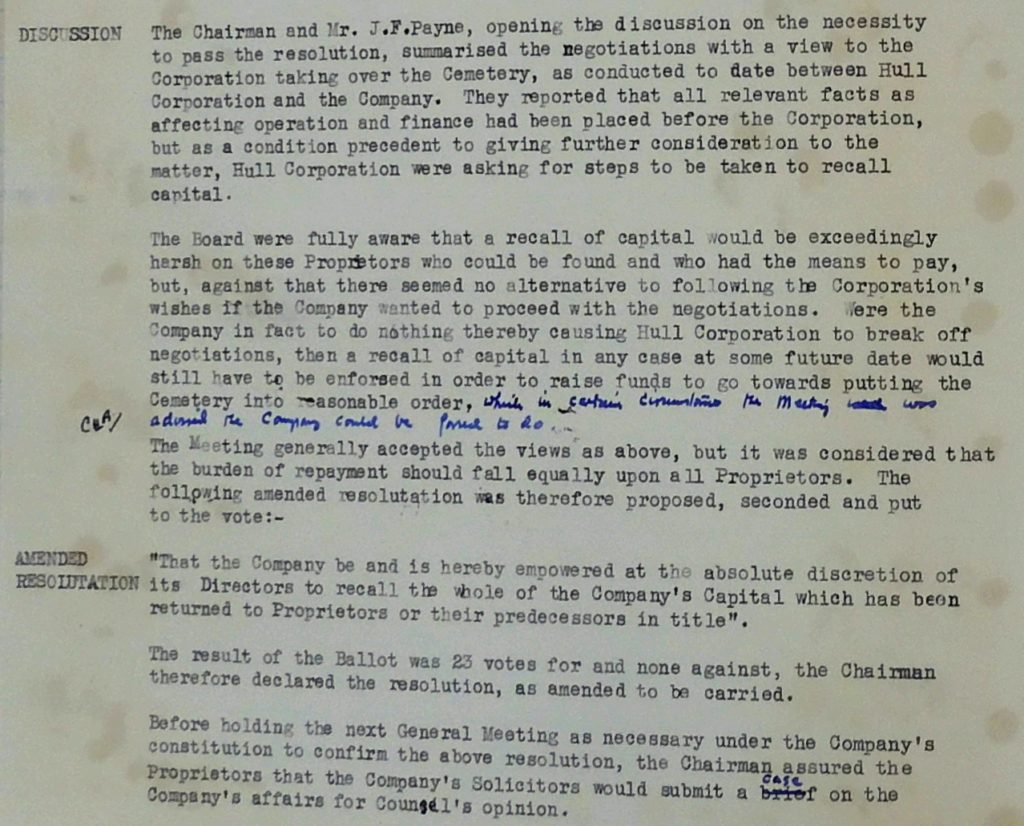
So the ‘burden’ of paying the £9 owing would not simply be taken up by the remaining proprietors but also by the relatives or descendants of all the shareholders. Some of these people may not have known they were shareholders in the Company. Those old shares could be mouldering in a trunk in the attic or have been lost over the intervening period of a century. It’s doubtful whether any of them had received any dividends over time as addresses would have changed.
This put the Company in an invidious position. They would now need to source where these ‘missing’ proprietors were and that would take money. Something the Company were sadly lacking in.
Realising that this task was impossible. the Chair and the Company’s solicitors, Payne and Payne, had, by June 1956, opted for hopefully an easier way. They approached the Corporation to accept £3 10 shillings per share rather than the full £9. The Board thought that this approach at least passed the buck back to the Corporation. The Board felt that it showed their willingness to compromise on the issue and provide a solution.
By January 1957 the Board heard that,

At a board meeting on the 21st August that year the Directors were informed that the site visit had been undertaken. Mr Roscoe, the Corporation Parks and Burials Superintendent, had visited the site. In researching this article I have not had sight of the report. However what we do have is a resume of the report and the conclusions of the Town Clerk, J Haydon W. Glen. It’s not pretty reading for the Company.
It starts quite positively and then takes a turn for the worst.
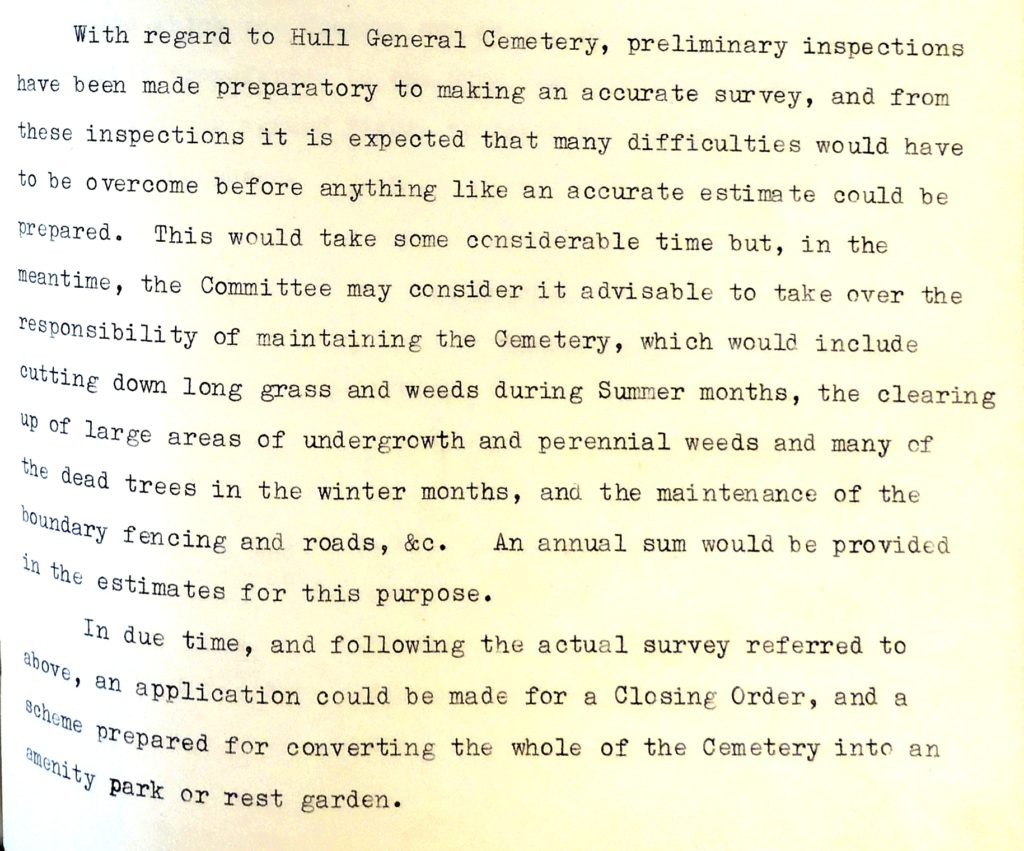
It went on to say,
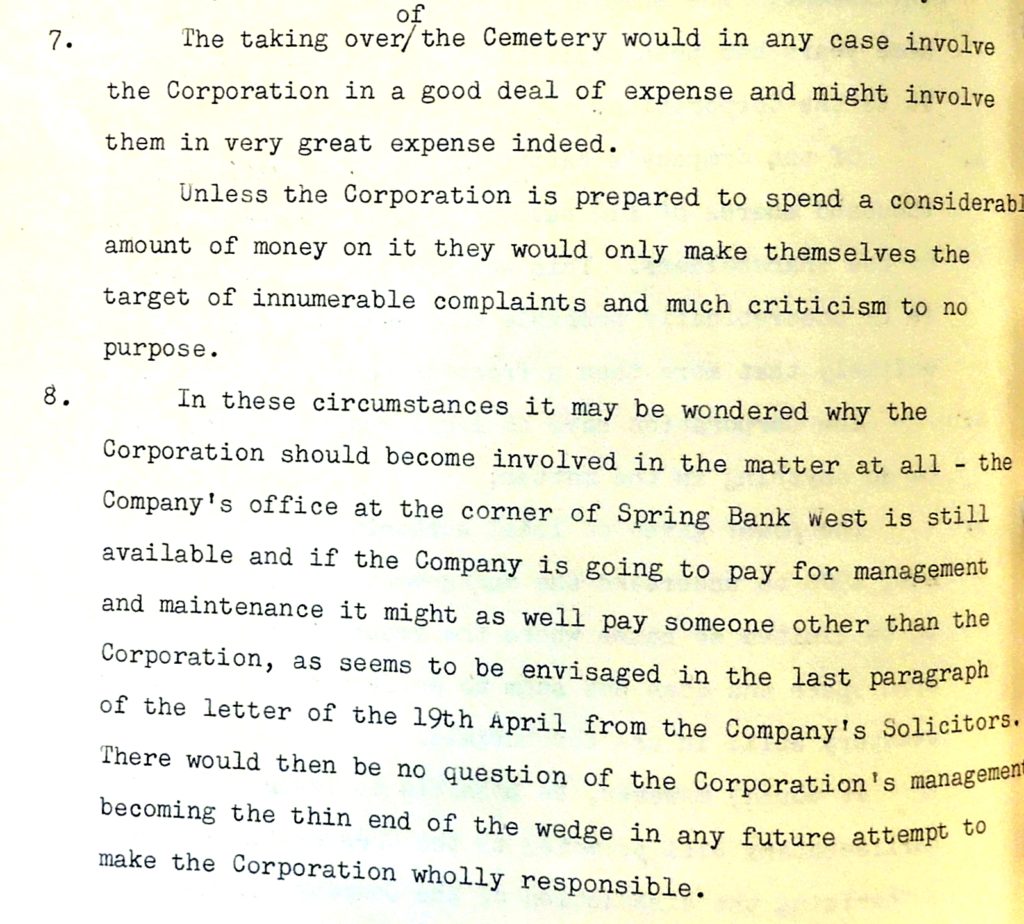
The resume by the Town Clerk was simply saying that the Company had managed to get itself into this mess, was still in business, so should endeavour to get itself out of it. As it says, ‘it may be wondered why the Corporation should get involved in the matter at all.’ And an objective observer would probably agree with them. It needed the Company to fail completely before the site could be rescued.
With that report, the hope that the Company had of the Corporation taking the site over was gone.
In November 1961 the Company formally recognised this and recorded that they would not approach the Corporation again. The issue resurfaces indirectly in November 1966 when the Company asked for another look at their own counsel’s advice from a decade ago. This advice had been to sell the site quickly as may be seen below,
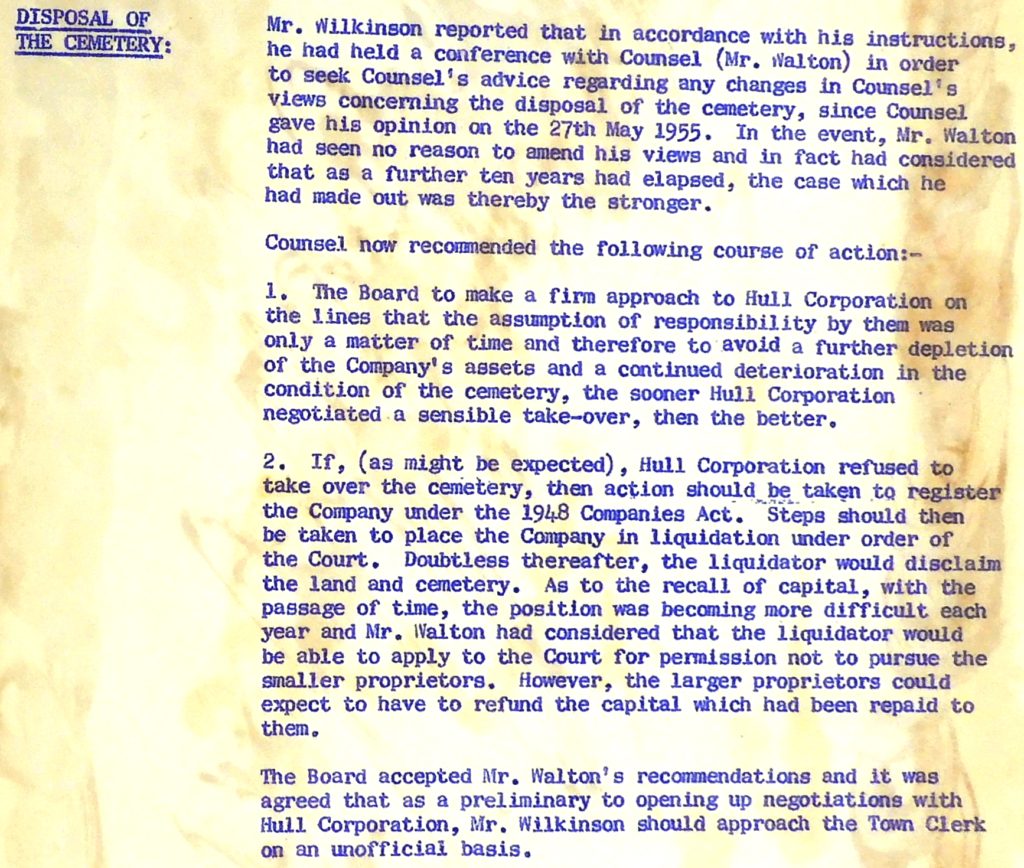
At the next meeting of the Board on the 27th August 1968 Mr Wilkinson reported back. He said that although the Corporation were not unsympathetic to the Company, they said they themselves did not ‘have the resources to take the initiative in the matter.’ As such the Corporation said the Company ‘must do what it thought fit.‘
Upon this news the Directors decided to undertake another plan. This was to list the Company under the Companies Act 1948. Taking this approach meant that the Company could apply to the Courts to be liquidated under that Act. The Extraordinary General Meeting (EGM) of the proprietors that would vote on this issue was to take place on the 11th August 1970. The Board were confident it would be approved.
At this meeting 10 proprietors attended, owning 153 shares between them. The chair outlined the situation facing all those present after which the outcome was a foregone conclusion. A resolution was put forward from the floor and it was unanimously accepted.
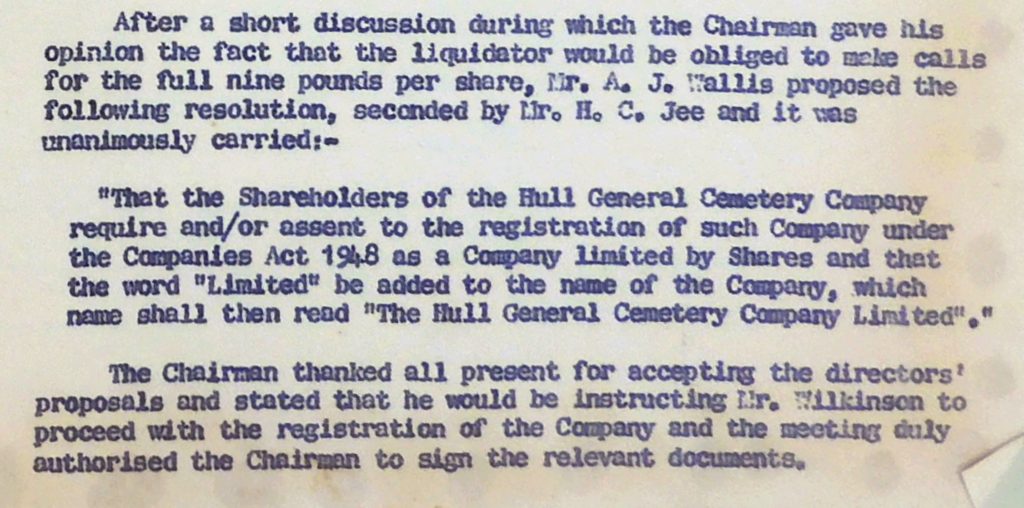
From now on the liquidation of the Company was simply a matter of when. Over the next 20 months the process of liquidation followed its legal course. By May 1972 everything was in place for the Company to be terminated. And then, at the eleventh hour, an outside intervention occurred.
On the 22nd May, at the Law Society Offices, Bowlalley Lane, another EGM took place. In an unconscious ironic twist of fate both this and the final shareholder’s meeting took place in the very building that the first meeting of the Company had taken place in back in 1845. Out of the 967 shareholders known to the Company only seven were present. However those present did own the majority of the Company’s shares between them.
At this meeting in May, Clifford H Ashburn, the chair, invited a Mr Dennis to speak. This young man, a Hull University graduate and now a businessman in a property company, outlined his proposal.
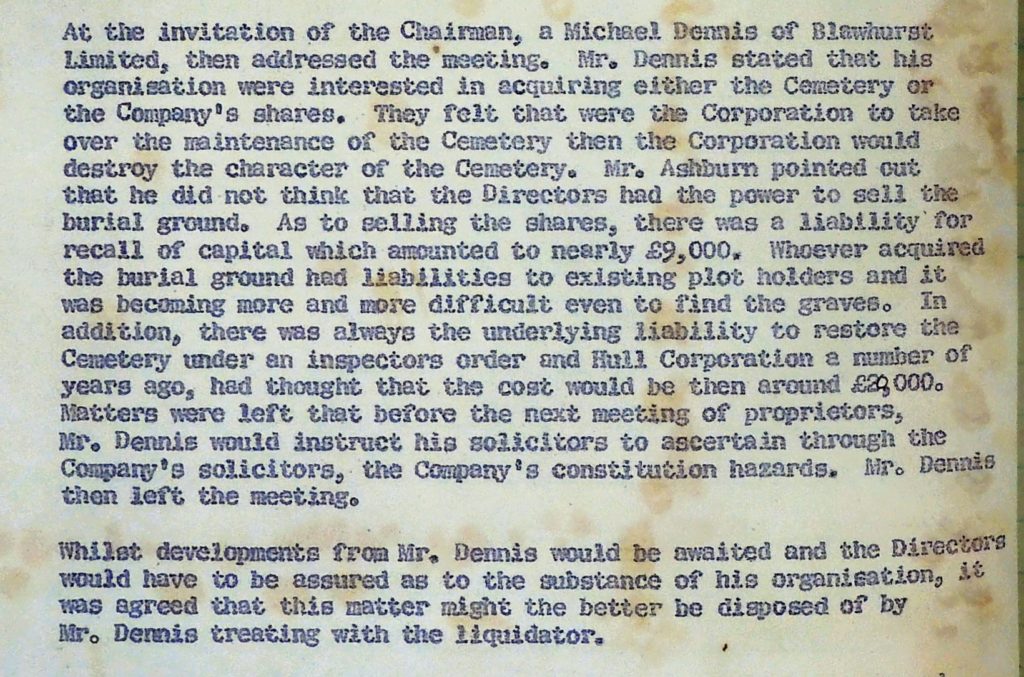
The chair had invited representatives of the local press and radio to this meeting. As such this late intervention was reported in the Hull Daily Mail the following day.
Under the headline ‘Hull Graduates Want To Buy Derelict Cemetery’, Mr Dennis’s scheme was explained. The article went into much more detail than the Company minute books. In essence it’s an intriguing ‘What If…’ aspect of the long history of the cemetery.
As the historian Hugh Trevor-Roper once said,
‘History is not merely what happened; it is what happened in the context of what might have happened.’
And with the intervention of Mr Dennis we have a perfect opportunity of imagining such a thing in connection with Hull General Cemetery. Could such an intervention have succeeded? What would have been the likely outcome over time?
On the credit side the Cemetery Company was not in debt. It still owned two properties. Yes, these were up for sale but that sale could be withdrawn. On the debit side it had no staff and the site was totally overgrown and shabby. However this last point appeared to be a credit point to the prospective buyers. In effect the site could have been transferred and the new owners have put into place their own plans. As long as the new owners closed the burial side of the business which the Company had already begun to do there would have been no legal objection that could have been sustained by the Council.
What then could have occurred? Mr Dennis said that a fence would be erected around the site. This would have been quite an expense. He also said that certain headstones and memorials would be made safe and restored. Once again this would have been an expensive undertaking. Other than making the paths of the cemetery passable no other work was envisaged. I would suppose that routine maintenance of the trees would have taken place to make sure they would not damage the stones but beyond that the site would be left in situ.
Mr Dennis did not say whether the venture would be income generating. However he was a businessman, even if he had long hair and ‘outlandish’ ideas, so it’s possible there was a germ of an idea to make money from the site. We do not know. However we can hypothesise.
Mr Dennis may well have foreseen that such a site could potentially generate money as a ‘heritage’ resource. We are all familiar with visiting country houses etc but accessing other sites rich in heritage is also viable. Possibly Mr Dennis may have had such an idea that the site could become such an attraction. With the rise of genealogical studies in the 1990s such sites became much more popular. Guided tours of the historic monuments (for a price) could have taken place. Accessing both local and central government funding for environmental and bio-diversity work could have also generated significant income. Another form of income generation could have been leasing it out as a film or television set. One can imagine how this could have been successful.
By the millennium the site could have become a self-sustaining part of the rich fabric of attractive heritage and natural highlights of the city.
Meanwhile back at the meeting, and the press report that followed.
The article began by stating that,
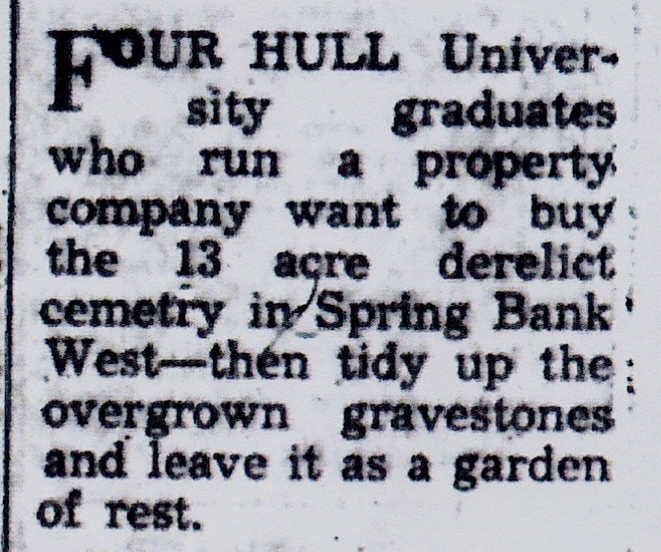
Mr Dennis, the representative of the graduates, stated,
‘that he feared the Hull Corporation would take over the cemetery, and by flattening it out, make it “a ghastly and tasteless plastic graveyard for plastic people.”.
Mr Dennis channelling Frank Zappa there! And of course he wasn’t far wrong in that assessment as a previous article pointed out. A Monumental Loss
Warming to his theme he outlined the plans he and his fellows had for the site,
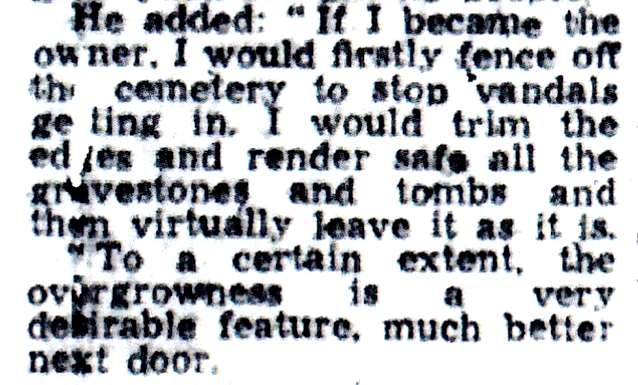
This was perhaps not what the present owners wanted to hear. They had lamented the state of the cemetery for the best part of 40 years without paying for its restoration. Now, sat in front of them, is this long haired ‘hippie’ saying that he and his fellows preferred this state of affairs and indeed wanted it to continue. One can imagine their consternation at this news.
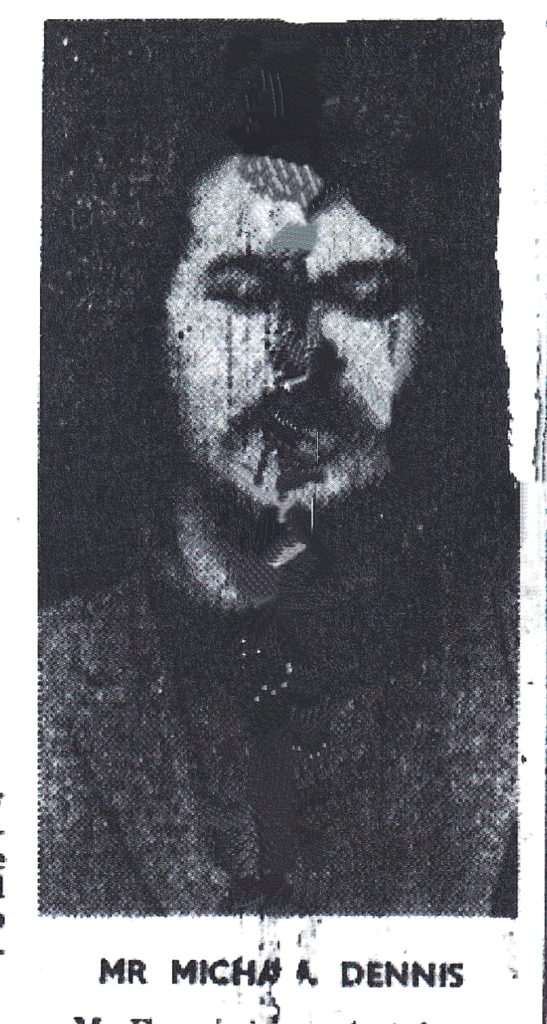
Under the paragraph heading, ‘Not Crazy’, Mr Dennis further outlined how he would take control of the cemetery,
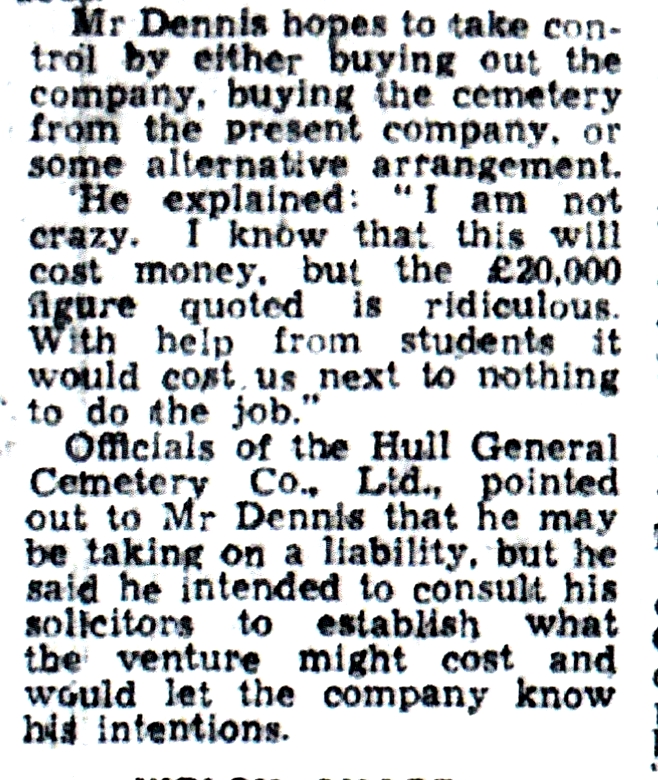
In the Yorkshire Post Mr Dennis was quoted as saying,
‘I want to buy it because it is a nice place just as it is – as long as it will not cost me too much. You could say I just want it as a garden. Let the place rest in peace whereas if the council got hold of it we would have council officials marching all over it, levelling it out. Many people enjoy looking around it in its present wild state. Let them enjoy the pleasure.’
He also said in the Hull Times that he did not want the Corporation, ‘to take over the cemetery, to make it into a second Queens Gardens.’
At the end of the Hull Daily Mail article the chair of the Cemetery Company poured cold water on this plan. He said he did not think it was possible for Blawhurst Limited, of which Mr Dennis was a founder, to buy the cemetery.
‘For one thing it may be too late to do anything now as we are well on the way to having the Company would up. It must be in doubt whether Mr Dennis’s company have enough cash. There are also various legal complication to be considered.’
With that cold assessment we now move on to the endgame of the Cemetery Company and to the final meeting of the Company. However, before we enter that meeting room for the last time, the intervention by Mr Dennis and his associates caused some ripples beyond the room.
On the 31st May, eight days after this meeting, the Joint Under-Secretary of State at the Department of the Environment (DOE), a Mr Keith Speed, revealed that Hull Corporation had already enquired for a direct grant from his department to ‘tidy up the dilapidated 127- year old cemetery.’

Sir Keith Speed, as he later became, was the minister for the Navy and was sacked by Margaret Thatcher in 1981. He had publicly disagreed with the cuts taking place on the Navy that she and the defence minister John Nott, were imposing. A year later, with the Falklands War, his assessment was proved correct. Naturally enough he was never forgiven by Thatcher and he was only knighted after she had left office. He died in 2018.
This embarrassing revelation for the Corporation came about, probably much to the Corporation’s chagrin, via the West Hull M.P. James Johnson at the time. He had received a letter from the DOE after he complained about the state of the site. So, contrary to past denials and negative pronouncements about the site the Hull Corporation were seeking to acquire it. But they did not want to buy it but ‘inherit’ it.
Responding to this news, Sir Leo Schultz, the leader of Hull City Council, said, ‘It was impossible at present to say whether the Corporation would step in.’ This statement, made no doubt to cover for the Corporation’s earlier machinations in applying for a DOE grant, continued,
‘There were plots which people had bought in the area but had not taken up, and the public still needed access to graves in the cemetery. The company is still using it as a burial ground, I understand, so we have commitments regarding it. this means we could not take steps to clear it up until the company has totally completed its business.’
The phrase, ‘to clear it up’, perhaps already shows the Corporation’s plans for the site. Ominously Sir Leo Schultz went on to say,
‘That in any case the Spring Bank area was not the only cemetery in the city which was untidy and needed attention. There were old cemeteries such as those near Division Road and Sculcoates Lane which also must be looked at under the clean-up scheme’
And so they were cleared up, with the significant loss of heritage assets such as the headstone of David Garbutt, the man behind the Avenues project, in Division Road. In Sculcoates Lane the destruction of the chapel that Greenwood in 1835 said was a great artistic piece of work was another blow to Hull historical record. ‘Clean-up’, as a phrase used by the Council at this time, surely should have struck fear into any historian.
The final meeting of the Company shareholders took place once again at the Bowlalley Lane site. The date was the 1st of June 1972. At this meeting two resolutions, unanimously agreed by all present were put forward. The first was that, ‘The Hull General Cemetery Company be dissolved.’ and the second stated, ‘That the Hull General Cemetery Company Limited be wound up in Court.‘
The shareholders then had to deal with the intervention by Mr Dennis and his associates. The shareholders had already agreed that they could not countenance this deal. As the minutes show,

It was only after the press were informed of this decision that Mr Dennis was asked to join the meeting. There he was not told that his offer had been rejected. He was asked to explain his offer once again which he did.
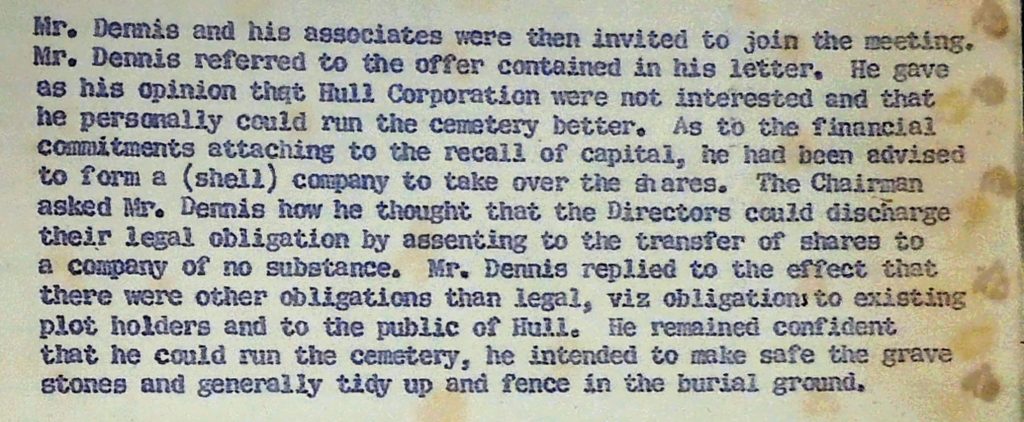
This approach would not have endeared him and his associates to the shareholders. He was saying that the cemetery, as it stood, was fine. That he could continue to run the cemetery as a business but that would not be its main function. Its main function would be as a site of historical and environmental interest. In essence Mr Dennis was stating something that to us today is quite normal but to the ears of the shareholders it was not only novel but dangerous. Indeed Mr Dennis was articulating what the Spring Bank Cemetery Action Group and the Friends of Hull General Cemetery said later. That the combination of both nature and history complimented each other and should be preserved as much as possible. That in it’s present state (in 1972) it was attractive and informative. The shareholders must have thought the young man was mad.
Meanwhile back at the meeting,
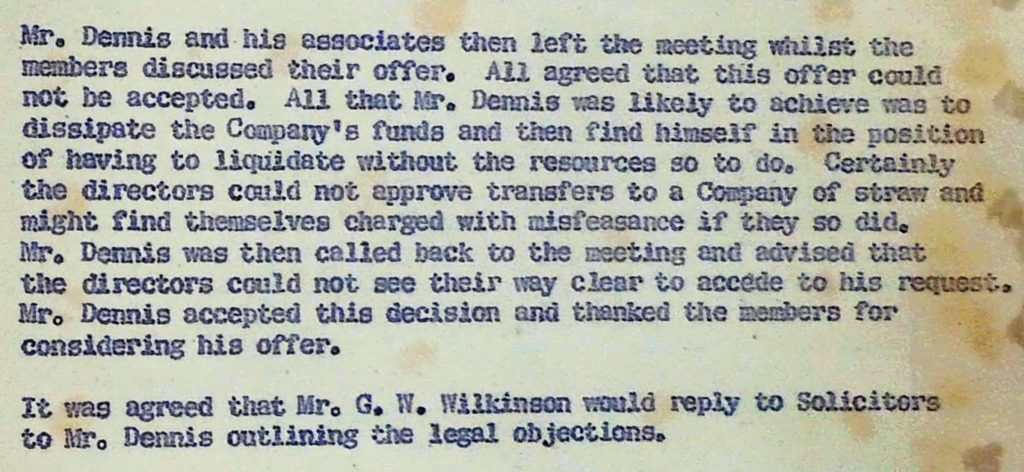
So the last chance to preserve the beauty of the Cemetery as it was was lost. That the directors stated that Blawhurst Ltd was a ‘company of straw’ is ironic as it is still one of the leading rental property owners in Hull. Once again one wonders what if the directors had gone along with this scheme what would we now have today on the site? A fruitless exercise I know but sometimes one can’t help playing such mind games.
The final minutes of the final meeting of the Hull General Cemetery Company were never signed off as no further meeting took place. In 1872 the Marie Celeste was found floating in the Atlantic with no one aboard yet still appearing as if it was crewed. One hundred years later so must the Hull General Cemetery have looked. The site continued to exist, the stones still stood in serried ranks, the wild things still scurried around and the trees and bushes still encroached further on to the paths. The site did not care a fig for legal obligations or who owned what. It just did what it does today; it continued to exist.
For 18 months the site was ownerless and then things changed. On December 14th 1973, under the headline, ‘City to buy derelict cemetery’, the open secret that the Hull Corporation would take over the site was revealed finally.
The article went on to say in an unflattering way, and it must be said that the Hull Daily Mail was one of the site’s severest critics. It never failed to use the word ‘eyesore for the site.
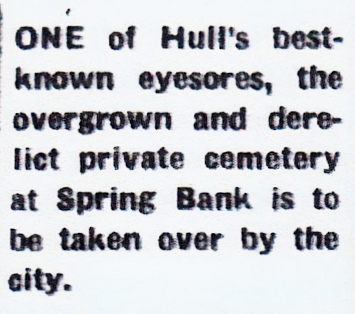
Perhaps more sinisterly, the plans for the site were expounded by Mr J.A. Milne, the Director of the Council Leisure Services Department.
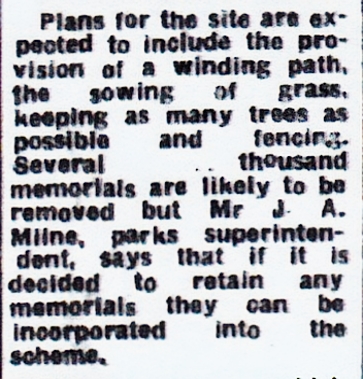
This is where this part of the story ends and the next stage of the story is already on this website. Please read it and realise what we have lost. A Monumental Loss
I attempted to contact Mr Dennis back in 2016. I was intrigued by this whole episode as I hope you are. He had since retired from his role as a Director of Blawhurst Ltd and now lived in Devon. Sadly I never received a reply to my enquiries and perhaps he felt that, as L.P. Hartley said in The Go-Between, ‘The past is foreign country; they do things differently there.’ Like us all he perhaps feels that his youthful indiscretions should remain hidden and forgotten. Who am I to argue with that? It is a shame though.
This is my last piece as editor of the website. It some ways it seems quite fitting to end with the end of the Company. It’s almost as if I had planned it that way which I assure you I hadn’t. I hope you have enjoyed these glances at some pieces of forgotten and ignored history. I hope you continue to enjoy the website and the cemetery itself for as long as you want to. Bye.

Pete Lowden is a member of the Friends of Hull General Cemetery committee which is committed to reclaiming the cemetery and returning it back to a community resource.


The grave site C37/3060 in Hull General Cemetery before the plot had been cleared in late 2021 and the parts of the headstone re-united.
The gravestone located in Hull General Cemetery had long been hidden beneath a thick bed of ivy and other vegetation. The “Friends” of the cemetery often referred to this plot as “Freddy Krüger’s Grave. Late in 2021, the volunteers decided to clear the plot and liberate the headstone from the vegetation, in doing so they found the stone was in two pieces, one of which was lying face down. Once the two parts had been reunited the inscription was clear and read as follows: –

The inscription reveals a close link between the Raines and the Krüger families. Interestingly there is a lack of any biographical information in contrast with other memorials in the Cemetery.
After research over several weeks the true story of the Krüger and other families was revealed and we find a story of the Baltic trade between Hull and Russia, shipwreck, tragedy, and philanthropy in Victorian Hull through to the early 20th century.

Sarah was one of at least three daughters of Rev. Robert and Elizabeth Raines, she was born in 1789 and baptised in Hull St. Mary on 3rd June and died 12th July 1861. She appears to have been a lady of independent means who lived all her life in Hull and never married. In the 1851 census she is living at 7 Spring Street, head of the household with a nephew and two servants. The nephew is registered as Edward Brebim aged 19 and working as an engineer, nationality, Russian born in Riga. (I have been unable to find any family connection to Edward and the surname is untraceable and suspect).
There is an entry in Pigot’s Directory of 1828/9 of Sarah Raines having a Millinery and Dressmaking business at 1 Jarratt Street. There are no other records of her being in business in Hull and no references to her in the local press.
However, we find a detailed press report in the Hull Packet of a trial at Somerset Assizes on March 29th 1800. A certain Mrs Leigh Perrott was charged with stealing lace in the shop of Miss Gregory, in the City of Bath. Miss Sarah Raines, apprentice to Miss Gregory (milliner and owner of the shop), swore that on the 8th of August the prisoner came to the shop……. and was a witness to the theft.
In the 1861 census records we find Sarah living at 24 Pearson Street with one servant where she dies of “decay of nature” in July the same year. There is no record of any obituary, will or probate.

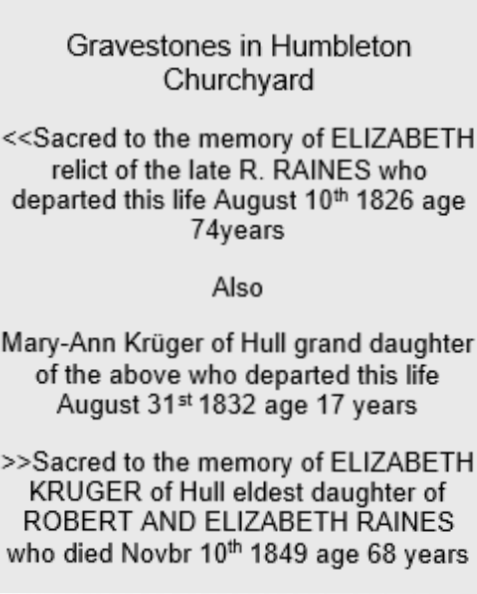

Sarah Raines’ sister Elizabeth was born in 1781 and died on 10th November, 1849, she is buried in Humbleton churchyard. She also had a sister Mary-Ann born in 1787 who was married to John Whitton.
Elizabeth married Francis Reimers, gentleman, on 18th February 1798 in Holy Trinity, Hull. They had two children: –
Francis Thomas born May 1800 and died January 1869 Christiana Elizabeth born December 1802
Francis Reimers died in August 1803 and buried in Hull St Mary on 30th August leaving Elizabeth a widow. His estate was valued at £100.
On the 7th March, 1810 Elizabeth marries “Jno. Frederick Krügar” in Holy Trinity, Hull. On his marriage to Elizabeth he is described as a German Teacher.
There are no official records of “John Frederick” in UK archives. His birth and death are not recorded but his marriage to Elizabeth Reimers (nee Raines) in 1810 is recorded in the Hull Trinity Parish record and there is a note of him being a clergyman in 1848 on the marriage of his son Henry Raines Krüger1 to Eleanor Blythe. There is no evidence of his presence at the marriage as a witness.
In the 1841 Census we also find Elizabeth living with her children from her first marriage at Prospect Street. Francis Thomas Reimers (her son) is head of the household, she is not described as a widow. It therefore seemed as if “John Frederick” was deceased by 1841 or had otherwise disappeared without trace.
1 There are two Henry Raines, son and grandson of Johann Friedrich Krüger
Later I found strong evidence of family ties to St. Petersburg in Russia and that Henry Raines Krüger (his grandson) spent time in St. Petersburg with his first wife Edith who died there in the Alexander Hospital in 1886. I therefore wondered if “John Frederick” was a Lutheran clergyman of Russian descent. I found there are two Lutheran cemeteries in St. Petersburg. In the Smolenskoe Lutheran Cemetery in St. Petersburg there are several “Krügers” interred and in particular Johann Joachim Friedrich Krüger. Born 3rd July 1797 and died 3rd December 1874 age 77 years. This would seem a good match as he would have been 33 years old in 1810 on his marriage to Elizabeth.

“Rest peacefully in your tomb, your saviour will welcome you”
A further search of the cemetery records failed to find Edith, first wife of Henry Raines Krüger who died in Alexandra Hospital in 1886 although there are several other “Krügers” interred there.
It would seem that Johann lived in St. Petersburg along with other members of the family and it is likely he worked as an agent for Hull merchants in the Balkan trade with Russia.

John Frederick was the youngest of Johann Friedrich’s three children, a merchant seaman, master mariner, latterly a marine surveyor and Trinity House Brother. He was called as an expert witness in several inquests into maritime accidents. He was clearly an esteemed member of the Hull community and there are numerous press reports of his close involvement, together with his brother Captain Henry Raines Krüger in the affairs of the Port of Hull Sailors’ Orphan Homes (see later).
In 1854 he married Emily Atkinson in Sculcoates, she was born in 1825 and died 28th October 1880 in Hull and is interred in Hull General Cemetery.
In the Merchant Seamen’s register (BT120), May 1836 he is Mate aged 25 on a ship belonging to Welton of Hull. Later in 1842 – 1844 he is recorded as a merchant seaman aboard the Royal William.
By 1851 he has become a Master Mariner living at 7 Spring Street. In July 1854 he was deemed qualified to be an expert witness at the Coroner’s Inquest into the loss of life resulting from the launch of the barque Dowthorpe which went awry (appendix 2).
In the 1861 census (ships at sea) he is Master of the paddle steamer PS LION along with his wife Emily, the Master’s wife aged 36 and his young son John Frederick aged 21/2.

The P S LION (pictures in Maritime Museum and Ferens Art Gallery) a Hull based paddle steamer,
626 tons, 320HP built by Brownlow & Co., Hull

During the Crimean War the ship was chartered by the government for the conveyance of troops and stores. After the war she was lengthened and converted to screw propulsion at 150HP and 690 tons, before conversion she required 650 tons of coal for the St. Petersburg voyage and now only 350 tons was required and was able to carry an extra 400 tons of cargo, and her speed increased from 6.5 to 8 knots.
On the 18th November 1861 the SS LION left Kronstadt and encountered a gale, Captain Winteringham and Captain Krüger a passenger managed to drive her ashore on the island of Gotland off the Swedish coast where she was driven to pieces in the gale. The crew and passengers managed to get ashore.
PROBATE of the will dated 18th February 1881, of the late Captain John Frederick Krüger of Hull, Marine Superintendent, who died on the 10th June last, and was one of the oldest members of the Hull Merchant Service and an Elder Brother of the Hull Trinity House, has been granted to the executors, his sons. Mr. Henry Raines Krüger and Mr. John Frederick Krüger and Mr Joseph Atkinson. The testator devises all his real estate for sale and bequeaths the proceeds and all residue of his property to his said two sons and his daughter, Mrs Sarah Raines, as his tenants in common, the value of the personal estate being £6.613 15s 8d.
Captain John Frederick and his brother Captain Henry Raines Krüger were prominent members of the merchant shipping community, Brethren of Trinity House and lifelong supporters of the Port of Hull Society’s Orphan Homes charity. Their dedication and generosity are recorded in a small book Lifebelt and Anchor published around 1900 recording the history of the Port of Hull Society as well as in numerous press reports of the activities of the society.


Capt. J. F. Krüger was one of the founding members of the Port of Hull Society and at the time of his death was the oldest serving member of the committee. He was connected with the earliest beginnings of the Orphanage and School. In conjunction with his brother Capt. H. R. Krüger, and Mr John Wright, he took an active interest in the enlargement of the orphanage when Mr Titus Salt gave his great contribution. (Titus Salt donated £5000 towards the cost of the new wing to accommodate an additional 100 orphans).
Capt. Krüger had been a member of the board of Trinity House since 1869, and he advocated the claims of the Orphanage with such zeal before the Trinity House brethren that they eventually became large subscribers to our funds, The generous subscriptions which, at this time were received from St. Petersburg, were also the result of Captain Krüger’s influence.
Lifebelt and Anchor, p125

Engraving reproduced from Lifebelt and Anchor
The Orphan’s Home is still in existence and is now the Park Hotel in Park Street.

On the façade of the former Sailor’s Orphans Home in Park Street, Commerce and Navigation are depicted providing Charity with the means to care for homeless waifs
The Book of Hull, John Markham
Captain Henry Raines Krüger, son of Johann Friedrich and younger brother of John Frederick, born in 1813. He died in March 1874.
In the same year (1874) the committee were saddened by the death of Mr H R Krüger, one of two brothers who were among the earliest and most zealous friends of the Society. He was a sea captain and an agent for Messrs. Brownlow & Lumsden, a prominent firm of Hull shippers at that time. His duties connected him very closely with Russia; indeed there was Russian blood in his veins. For thirty years he had served on the committee, and in work for the Orphan Home few could have been more faithful than he.
Lifeboat and Anchor, p 99
Henry was the eldest son of Captain John Frederick, born in June 1857 in Sculcoates he spent most of his early life as a forwarding clerk in the shipping trade. In the 1881 census he is living with his father John Frederick at 3, Wright Street. At this stage he is still single.
On the 27th December 1883 he marries Edith Kershaw in St. Paul’s Church, Sculcoates. Shortly after we find he and his new wife have relocated to St. Petersburg, Russia where she dies in the Alexander Hospital on the 24th February 1886.
PROBATE
17th April 1886
Personal estate £306
Administration (with the Will) of the Personal Estate of Edith Krüger (wife of Henry Raines Krüger) late of 37 Louis Street in the Borough of Kingston-upon-Hull who died 24th February 1886 at the Alexander Hospital, St. Petersburg in Russia was granted at YORK under certain Specialities to the said Henry Raines Krüger of 37 Louis Street and of 9 Fish Street both in Kingston-upon-Hull. Forwarding agent and John Frederick Krüger the younger of 3 Wright Street, Kingston-upon-Hull Provision Merchant the Executors.
I can find no record of her burial in St. Petersburg or anywhere else.
Henry must have remained in St. Petersburg for several more years, presumably either working with or for his father or grandfather in their shipping business as he is not recorded in the 1891 census.
By 1893 Henry has found a new life. He marries Mary Ellen Fergie in Wigan, gains a BA and is appointed to the curacy of Cullompton on the 15th June the same year. He continued his studies, gained an MA and is appointed Rector of Jacobstowe, Okehampton, Devon.
His widow, Mary Ellen retired to Hove, Sussex and died there on 30th November 1945, her estate was valued at £2,548.
Exeter and Plymouth Gazette, 18th September 1929
Devon Clergyman’s Death
The death has taken place of the Rev. H. R. Krüger, who at one time held the curacy at Cullompton and was later presented with the living at Jacobstowe by the late Sir R. T. White-Thomson. After working in the parish for some years he was offered one of the new churches built to meet the demand of the growing population in certain parts of Plymouth. On the death of the Rev. J. W. Banks, he was presented with the living at Hatherleigh, coming to reside in the parish in 1918. In the summer of 1927, while on holiday he had a seizure which left him practically paralysed and he was persuaded by his friends to retire from active work, and a Commission granted him a pension from his living, which in the meantime was accepted by the Rev. J. C Rossiter. Much sympathy was felt for Mrs. Krüger, who has been the indefatigable nurse and constant attendant ever since her husband’s sudden illness. A knell was rung on the bells from Holsworthy, and on Sunday the Vicar made feeling reference and asked for the prayers of his congregation on behalf of Mrs. Krüger.
John Frederick Krüger was the younger son of Captain John Frederick Krüger, born 18th September, 1858 in Sculcoates. We first find him aboard the PS LION with his mother and his father in command on route to Hamburg or one of the other Baltic ports. He soon becomes a shipping and merchant’s clerk, joins White & Sons fruit importers, and works his way up to senior management and a seat on the board.
John Frederick married Harriet Anne Gray on the 18th October 1888 in the Herrington Street Chapel in Sunderland.
He was evidently a valued employee and on good terms with Colonel William Lambert White, governing director of White and Sons fruit importers as he received a gift of £100 as a token of his friendship. (Hull Daily Mail, 23rd September 1930)
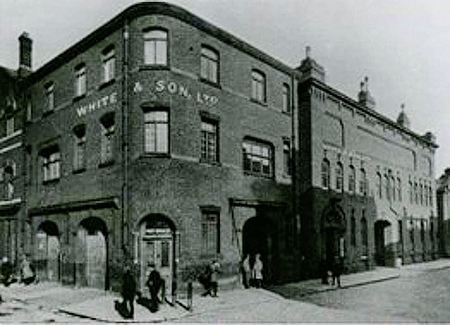
Yorkshire Post
Monday December 12th, 1932
Pioneer of the Australian Apple Trade in Hull
Mr John Frederick Krüger, who has died at his home, 23 Park Avenue, Hull, was the pioneer of the large trade in Australian Apples now done by the port. He was a director of the firm of White and Sons, Ltd fruit importers and spent 58 years with it having joined in 1874, when the business was carried on under the style of White and Son and Strutten. He went overseas a great deal for the company.
In 1912 he was in Australia and through his initiative the first direct consignment of Australian apples was sent to Hull. The trade was developed considerably, over 400,000 boxes being imported to Hull last year. At a later date he also arranged for direct shipment of apples from South Africa but owing to the difficulty of obtaining return cargoes they had to be discontinued. A dinner was given in his honour in 1924 to celebrate 50 years with the trade.
This has been a fascinating journey through the history of merchant shipping and people of the Port of Hull in Victorian England. It has been a challenge to condense all the information I have gleaned into a concise biographical story of the Raines and Krüger families, their ancestors and descendants.
I was fortunate to find the small textbook on the history of the Port of Hull Society’s Sailors’ Orphan Homes in the Carnegie Centre “Lifebelt and Anchor” (H362.73) in which I found the images of Captains J. F and H. R Krüger together with the engraving of the orphanage in Park Street.
Finally, I want to thank Karen Towner for her encouragement and advice in compiling this biography
This page reproduced from Lifeboat and Anchor, the history of the Port of Hull Society showing the eminent benefactors of the Society.
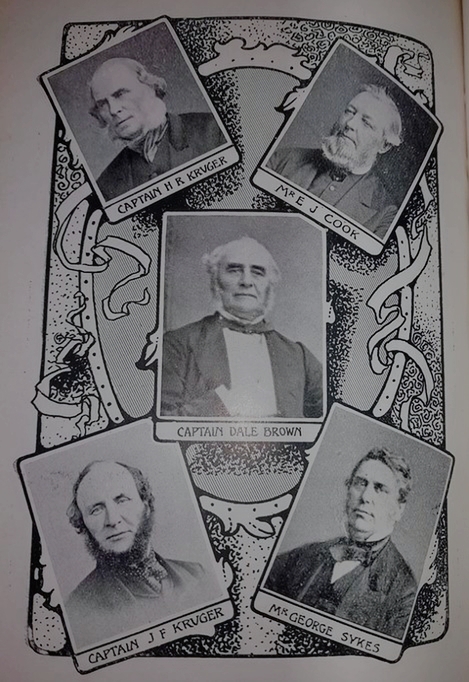
Illustrated London News, July 22nd, 1854
LOSS OF LIFE AT SHIP LAUNCH

On the morning of Thursday week, Messrs. Earles, the eminent iron shipbuilders, of Hull, had arranged to launch from their yard at the east end of Victoria Dock, a very fine iron barque, named the Dowthorpe which they had built for Messrs John Beadle and Co., merchants of Hull.
This vessel is about 400 tons burthen and has on deck two poop houses. Everything was prepared, and as it was thought, every precaution taken to ensure success in the launching. Men were stationed at all posts to prevent people from getting on board the vessel, but without avail. At the time of launching there were between 300 and 400 persons on board, and of these, as many as could conceivably stand had stationed themselves on the roof of the poop houses where there was not a scrap of rope or an inch of bulwark to hold on by.
At about ten minutes past eleven o’clock the ceremony of naming the vessel Dowthorpe was performed by Miss Baird, the last of the wedges was knocked out, and the good ship glided easily and well into the water. At time it was found, we are informed, that there was too much “way” on her and some efforts were made to check her. At the same time the people on board, with the usual carelessness of danger, commenced “sallying” her – that is rushing from side to side, to make her rock in the water. Down she dipped on one side, and at this moment one of the check ropes broke, bringing the whole strain of checking on the other side, to which at the same moment the people rushed.
The combined influence of the two forces heeled the vessel completely on her beam ends, and the unfortunate people who had taken their stand on the “poops” were shot into the water one upon the other. For the moment it was thought the ship would go over altogether; but fortunately, at this moment the other check rope broke, and this, together with the lightening of the top load, by the precipitation of the people into the water, enable the vessel to right herself. In the meantime there were between fifty and sixty men and boys struggling in the water, pressing on each other to make their escape.
Happily, there were several rafts of timber floating in the dock, and upon these clambered a large proportion of the unfortunates. The loss, therefore, is not so great as might have been feared, four persons only having been dragged up. The names of the persons who have been found drowned are John Jackson, twenty-two years of age, rivet man; Joseph Lucas, fourteen, son of Mr. Lucas, hairdresser; John Coulon, twenty-four, labourer; and John Shipson, nineteen, ship-carpenter
This is an article that Bill Longbone produced some years ago for the Facebook site. In it he listed a number of women who were independent minded, resourceful and also influential. They also had a connection to Hull General Cemetery.
Bill called the article ‘Inspirational Women’ and the title fundamentally says it all. With one or two changes here it is once again for your pleasure.
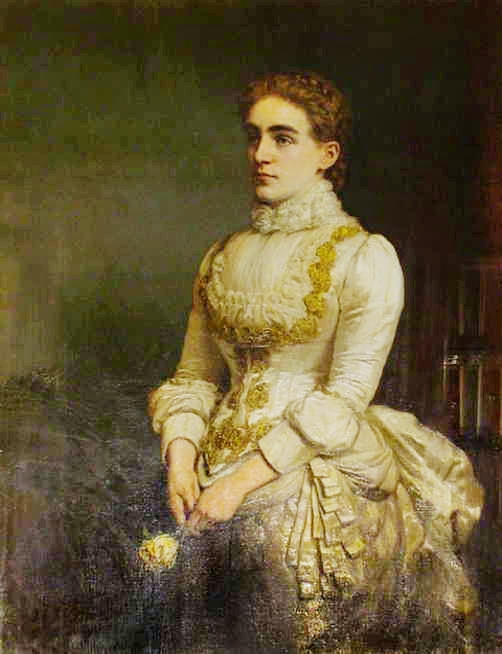
Eleanor Rollit (Bailey) was born in Hull in 1853, the 2nd daughter of ship builder, William Bailey and Mary Badger Ainley. William was a self made man, and a partner in the steamship company, Bailey & Leetham, which was taken over by Thomas Wilson & Co. in 1903. William was a JP, and a director of the Hull Dock Company and lived at White Hall, Winestead.
Eleanor married Albert Kaye Rollit at the newly opened, St Peter’s Church, Anlaby on 26th August 1872 when she was just 18 years old. Her brother, Walter Samuel Bailey, of The Mansion, Anlaby, married Albert’s sister, Ellen Rollit.
Albert Kaye Rollit, was the son of solicitor John Rollit, and brother of Arthur, also a renowned solicitor who lived at Browsholme, Cottingham. Albert became a successful eventually became President of the Law Society, and was later knighted.
In 1874 their only daughter, Ellen Kaye was born, and the family lived at Thwaite House in Cottingham. Eleanor was very involved with local charities, and was a great supporter and benefactor of the Sailor’s Orphanage on Spring Bank, she was also a patron of the training ship T.S. Southampton, that trained wayward boys and orphans in the basics of seamanship, and was moored in the Humber at the mouth of the River Hull. Eleanor personally opened bank accounts with the Hull Savings Bank for the boys.
Eleanor was always referred to as charitable and philanthropic, she organized annual visits and fetes at the family house in Thwaite Street, for the children of the orphanage, and subscribed towards a new wing at the Hull Royal Hospital in Prospect Street.
When her husband became Mayor of Hull in 1883-1885, Eleanor became Lady Mayoress and extended her support for local charities and good causes. She was also very active in the early women’s suffrage movement. Sadly, during her tenure of Lady Mayoress, she suffered heart problems, and died on 11 January 1885, aged only 31.
Her funeral was attended by ex-mayors, councillors and many of the local dignitaries. The cortege, which left from the family house in Cottingham, was lined all the way to Hull General Cemetery, with crowds of in excess of 20,000 people, including the orphans of the Sailor’s Orphan Homes. Her portrait was painted by Ernest Gustave Giradot and hangs in The Guildhall, a marble bust by local sculptor William Day Keyworth junior is also in the Guildhall.

In1892, her husband, Sir Albert Rollit, put a private members bill supporting votes for women, no doubt inspired by his wife’s work.
She was buried in the family grave, which includes her father in law, John Rollit and some of his children. Her headstone still remains in HGC, but the top section with her epitaph has been removed, and is in need of some repair work, (see photo below).
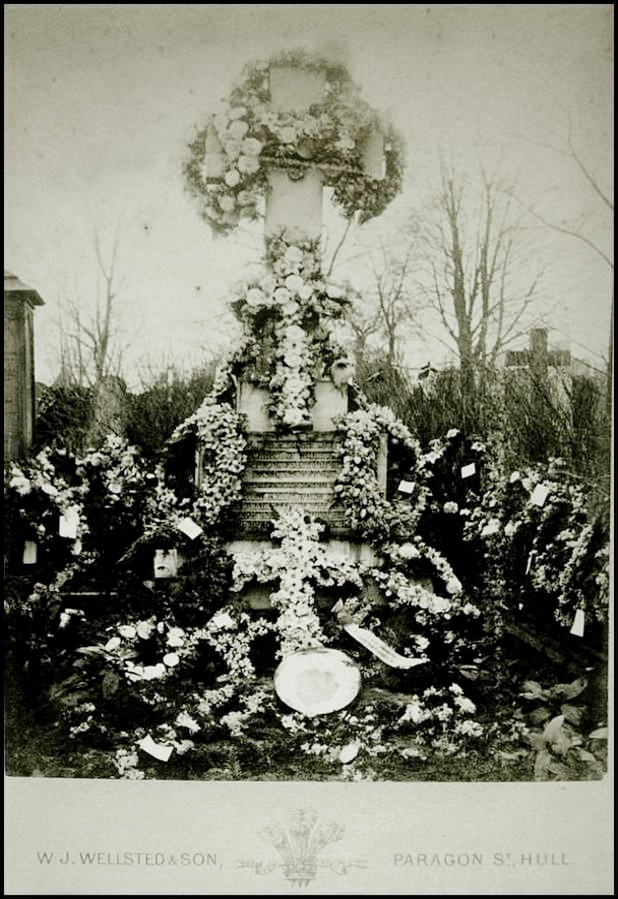
‘The Friends’ are looking at a proposal to carry out restoration work to the headstone.
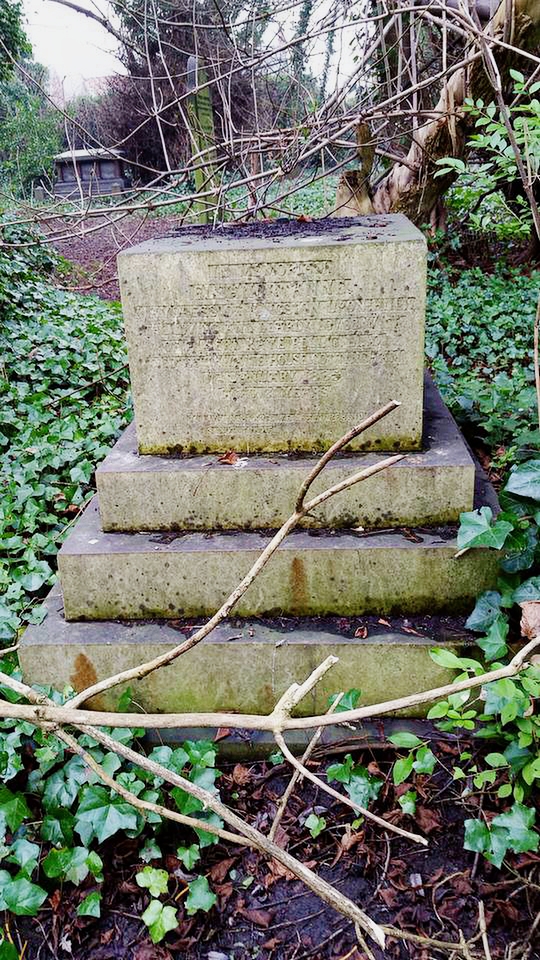
Her husband, Albert, moved to London and remarried the controversial and twice married, Mary Caroline Michell, Dowager of Sutherland in 1896, he died in 1922, his cremated remains are in the family grave in Hull General Cemetery.
Thwaite House, was later purchased by the University of Hull, the gardens were used by the Botany Department the house became Halls of Residence called Thwaite Hall. The house and grounds are currently being sold by the University.
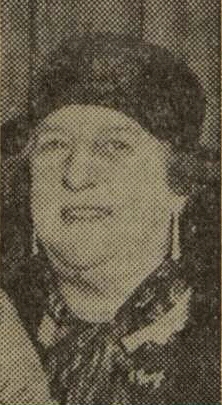
Mary Alice Sharrah was born in Hull in1863, the daughter of William Simpson Sharrah, a prominent Wesleyan, who was The Seaman’s Missionary for the Port of Hull, and his wife Mary Ann. She taught music from an early age, setting up the Hull School of Music (The first school of music in England), in 1887, originally from her family home at 22 Reed Street, and later at 55 Spring Bank.
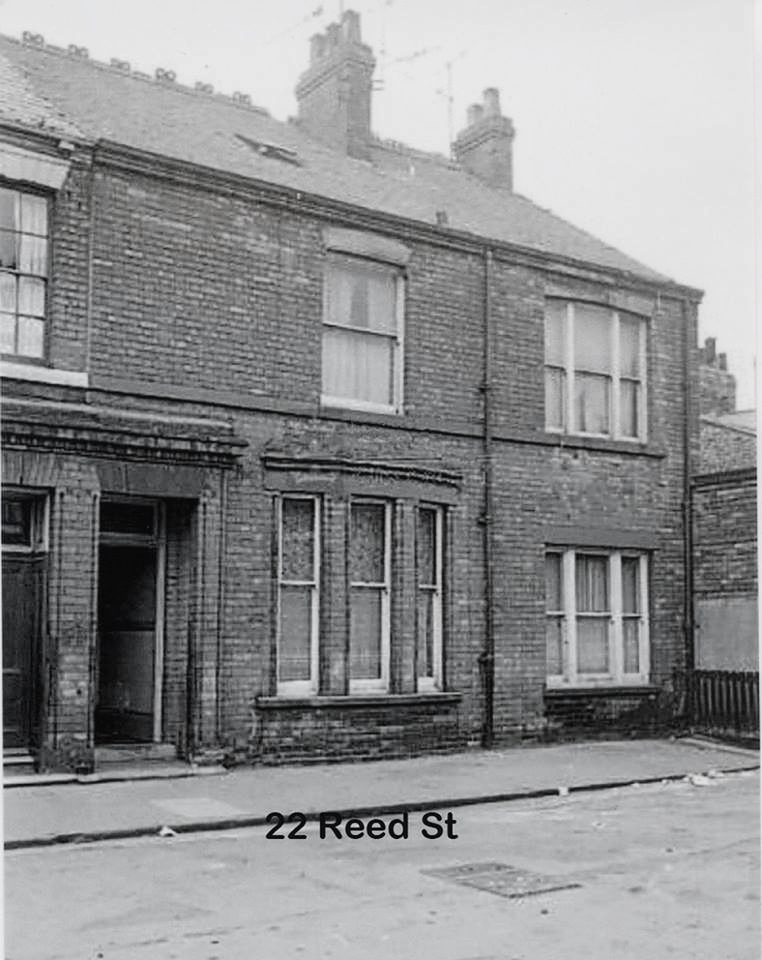
In 1894 she married William Henry Simpson, a director of a local grain merchant’s, and lived at their large house at 55 Spring Bank, which still exists. For teaching purposes she kept her maiden name of Sharrah, and referred to herself as ‘Madame Sharrah’. As well as music, she also taught drama and elocution, instructing many local talents such as Annie Croft, her son David Croft of Dad’s Army etc, Doris White and many others.
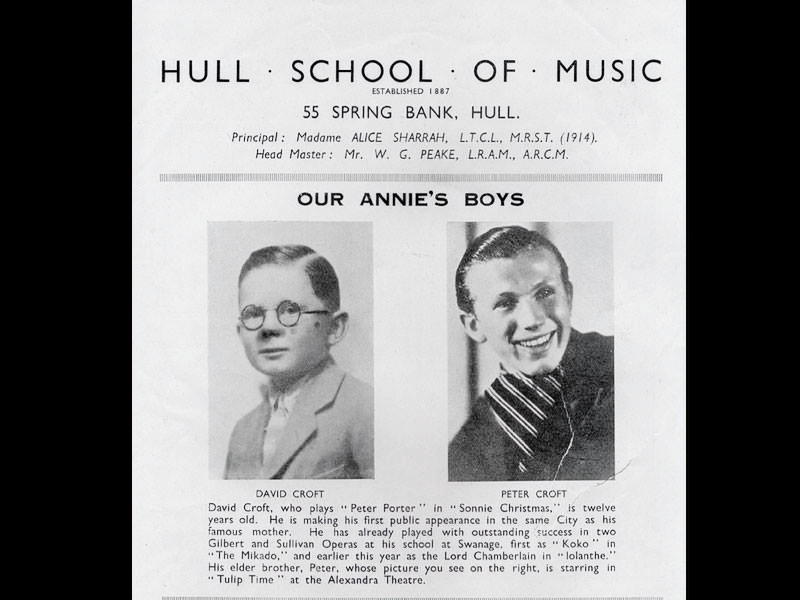
Madame Sharrah supported many charitable institutions with her shows and concerts, including The Mother Humber Fund, Newland Orphan Homes and the Hesslewood Orphanage. Throughout WW1 Alice was responsible for organizing many concerts in aid of servicemen.
Her daughter, Phyllis Sharrah continued the school after her mother’s death on 25th May 1940, amalgamating with Sizer Simpson School. The premises became 55 Antiques in the 1960’s, next to The Silhouette Club, and is now part of a number of listed buildings in the Belgrave block.
The entire family of father, mother and Mary are all buried in Hull General Cemetery, but sadly the headstones have been removed.
Mary Kirk Mawmill was born in Beverley on 7th October 1810, the daughter of William & Hannah Mawmill. She married Edward Robinson Harland in Hull on 11th August 1832. Edward had been indentured to be a greengrocer, but a year after his marriage he started his own printing business at 14 Carlisle Street, (a street later demolished to make way for Jameson Street).
They lived near the business premises in Carlisle Street, and had 5 children, employing 2 apprentices. Unfortunately, Edward died suddenly in 1844 aged only 33, leaving Mary with 5 young children and a business to run.
Mary was unphased by this set-back, and continued to run the business and bring up her young children. Under her stewardship, the business grew from strength to strength. She was described in the Hull Daily Mail as ‘a woman of rare business qualities, succeeding in keeping the Company together in the midst of great difficulty’.
A further set back occurred to Mary when her daughter, Emma, died in 1855 aged 20.
However, the business continued to expand, and became involved in the printing of tickets, two of her sons, William and Edward also joined the company to assist in the running of the Company. However, William died in 1880 aged 38, the company name was recorded as M Harland & Son. The other son Thomas, died in New Zealand in 1907 aged 74, the remaining daughter, Sarah, died in 1910 aged 73.
Mary died of an apoplexy at her home at 104 Regent Street on 3rd November 1885 aged 75, and was buried in Hull General Cemetery. After her death Edward took over the company, and moved to larger premises, to what was known as Phoenix Works, in Land of Green Ginger, although the correct address was Manor Street.
The company became one of the largest printing companies in Hull, moving to Springfield Way, Anlaby in the 1960s, and innovating into data printing and bar code systems. I believe that the company was taken over by a multi-national printing company in the 1990s, and business transferred to Eastern Europe, but a management buy-out took place and the company still trade at their Marfleet premises on Hedon Road.
Sadly, Mary’s headstone no longer exists, and she is not recorded in the MI books. She certainly was a resourceful and inspirational woman.
Mary was also the great grandmother of Annie Croft, the well known Hull actress and singer, but that’s another story…….
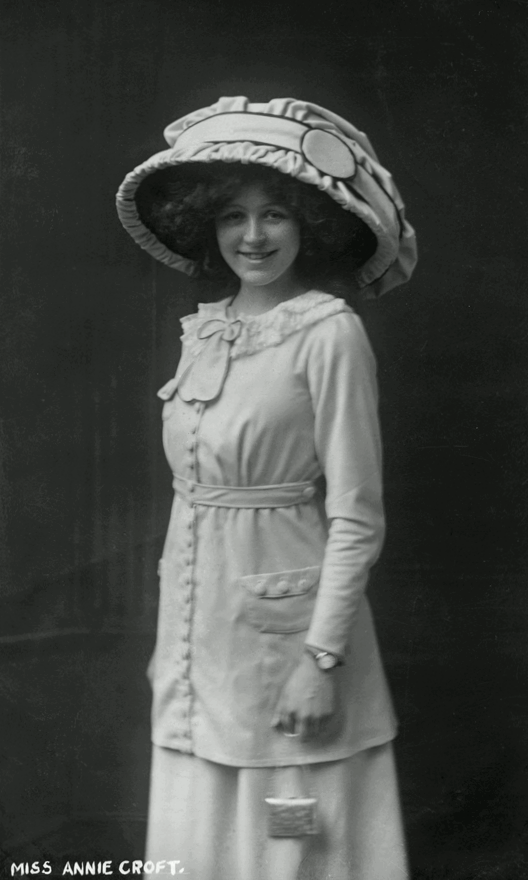
Many people will have heard of Annie Croft, the Hull girl who became an international star of stage and screen, but few will know of her fascinating story.
Although, not buried in HGC, she is very much associated with it, as her great grandmother, Mary Harland and the woman behind the success of Harland’s Printers is buried there.
Annie Croft was born Gertrude Mulgrave on 17th August 1892 at 11 Tuke’s Terrace, Walker Street, to Frederick Steele Mulgrave and his wife Lily Ann (Davis).
She was adopted by Michael Croft (1853-1895) and his wife Emma, the daughter of Thomas Harland and the grand daughter of Mary Harland, who we have discussed previously. She was baptised as ‘Annie Harland Croft, the adopted daughter of Michael & Emma Croft of 424 Hessle Road at the Wesleyan Methodist Chapel at the corner of St George’s Road on 24th November 1892. Michael and Emma had a shop on the opposite corner of St George’s Road to the chapel.
Over the years there has been much unfounded rumour regarding the parentage of Annie Croft. The ‘story’ was that she was the illegitimate daughter of Muriel Wilson, the daughter of Arthur Wilson and Edward Prince of Wales, (later King Edward VII), after an affair whilst the future king was staying at Tranby Croft. Whilst it is true that Prince Edward regularly stayed at Tranby Croft, (he was there at the infamous ‘Baccarat Scandal’) it has been proven beyond doubt that Annie’s ‘royal parentage’ was just a rumour.
Sadly, Annie’s adopted father, Michael Croft, died in 1895 aged just 41, leaving Emma to bring her daughter up on her own, but with some financial help from her father Thomas Harland.
Emma remarried William Drury, (a sea pilot) in 1898 and lived at 32 Waverley Street. Apparently William was a brusque man who liked a drink. He died in 1914, when Annie was 20 years old.

Annie joined Madame Sharrah’s ‘Hull School of Music’ when a young girl. She quickly became known as a talented singer and dancer, appearing in many of Mme Sharrah’s concerts and shows. In 1907, when only 16 years old, Annie decided to form her own school of dancing and music, which she called the Waverley Academy of Music, operating initially at the family home in Waverley Street, later moving to 5 Fountain Street.

In addition to teaching dancing, acting and singing, Annie produced many concerts and plays at the local theatres. During WW1 she produced many shows supporting local charities and raising money for servicemen.
Annie’s talents were well noted and she was offered parts in plays in London, and film roles. She married American stage and film star, Reginald Sharland (1886-1944), in Hull in 1914, and appeared in many plays with him. They later moved to Bournemouth. They had two children, Peter, (1917-1988), and David Sharland (1922-2011), both of whom trained at Madame Sharrah’s Hull School of Music and adopted the stage names Croft.
David Croft became famous as the writer of several BBC sitcoms, including, Dad’s Army, Are You Being Served?, Allo, Allo, It Ain’t Half Hot Mum, and Hi-De-Hi.
Annie divorced Reginald Sharland in 1931, and remarried Francis Gough in 1938.
Annie died in Dorset died on 23rd March 1959. She was aged 66.
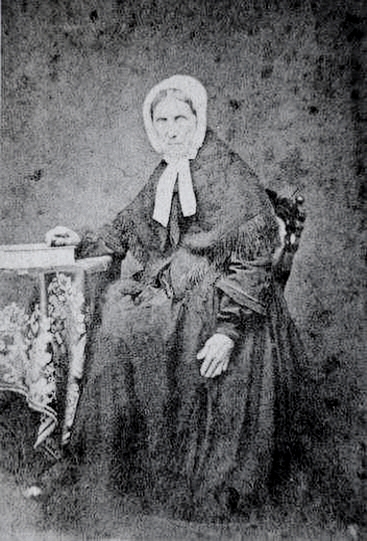
Jane (Barnborough) was born in Preston in 1778, and married John Wing at Holy Trinity Church, Hull on 21 Feb 1811. John was born in 1777 at Beeford, and had moved to Patrington some time before 1791, where he had set up a small post office and a mail coach service. The coach ran from Hull to Patrington twice a week, and although less than 20 miles distant, the journey took a minimum of 4 hours. This was at a time when the route to Holderness was via the turnpike road at Wyton Bar, Preston, Hedon and Thorngumbald.
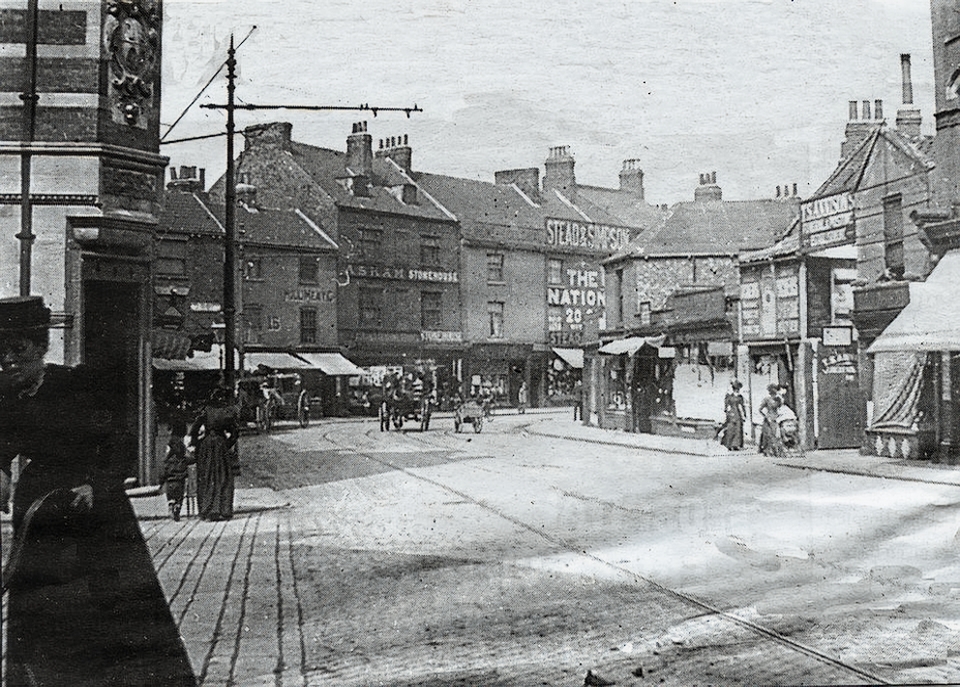

The business was very successful. John & Jane moved their premises to North Bridge Foot. This was situated at the junction of Witham and Gt Union Street.
Jane and John had at least 7 children, Thomas, John, Jane, Robert, William, George (died in infancy), and David.
In 1826, John died suddenly, aged only 49, leaving Jane to bring up the family on her own. Jane took up the challenge, and managed to continue running the coaching business with the assistance of her son John. He also ran The Holderness New Inn on the corner of Witham and Dansom Lane. John also developed a further coach route to Hornsea.
In December 1844, aged 67, Jane successfully applied for entry into the Hull Charterhouse. This was probably with the assistance of her youngest son, David. For many years he was a Poor Relief Officer for South Myton District.
However, in 1858 further tragedy struck when John junior died aged 46. His elder brother, Thomas, who in 1848 was recorded as having the Carpenter’s Arms and livery stables in Gt Union Street, took over the running of the business and The Holderness New Inn. He gave it up though, probably because of construction of the Hull to Hornsea Railway in 1862.
Thomas, moved to the St Stephen’s area of Hull, where he became an inn-keeper and coach proprietor.
Jane’s only daughter, Jane, married Samuel Fisher who ran a druggist store at Wilton Terrace, Holderness Road, next door to the ship’s chandler, and Quaker, John Good. Another son, Robert was a clerk at a commercial druggist. A further son, William, emigrated to Australia.
Ten years after Jane entered the Charterhouse, on 27 June 1854, the Hull to Withernsea railway line opened, cutting the journey time from Hull to Patrington to about ½ hour. This must have greatly affected the business that Jane had developed. However, a coach service ran to Patrington for some time after.
Jane died in The Charterhouse on 23 October 1861 of ‘Decay of Nature’ aged 83, and is buried in HGC with several members of her daughter’s family, the Fisher’s. The headstone was sadly removed in the 1970s.
Julia Hammond was born 31st December 1859 in Wisbech. She was the youngest of 10 children born to labourer, Christopher Hammond and and his wife Martha (Canham).
In the late 1860s the family moved to Hull, and lived at 3 Fanny’s Terrace, Clarendon Street. Her father died in 1871 aged 51, leaving her mother, Martha, to raise the children. Martha married John Hare in 1874, but she died in 1885.
On 28th March 1875, when Julia was still only 15, she married George Turpin at St. Andrews Church, Kirk Ella. She was illiterate at the time, and simply put her mark. She was also under the marrying age and incorrectly stated her age as 18. Both gave their addresses as Wold Carr, which was approximately where Parkfield Drive is now, and would have been in the Kirk Ella Parish.
George was born in 1858 at Oxmardyke, near Gilberdyke. He was the son of Mark Turpin and Hannah (Simms) of Cliffe, near Market Weighton. At the time of their marriage, George’s occupation was given as a labourer. He later became a plate layer on the railways, eventually becoming an engine driver. They had 15 children, only 10 of which survived childhood. In 1881 the family was living at Cliffe, later moving to 13, Filey Terrace, Gillett Street, and then to 11 Gillett Street.
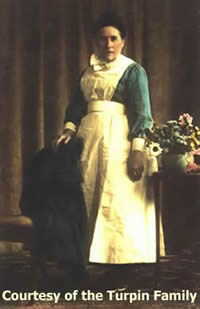
Although having very little formal education, and being unable to read and write, Julia trained to become a midwife. This was at a time when only unmarried mothers and poor women actually gave birth in hospital. Prior to 1900, women in Hull were 6 times more likely to die from an infection in hospital, than at home. At that time, the majority of births in working class areas in Hull, were attended by a ‘local woman’, who would have experience of attending births, but would not be qualified.
Increasingly concerned about the infant mortality rate, the government introduced the Midwives Act in 1902. This meant that all midwives had to be qualified and registered. It took a couple of years to fully implement. Hull opened its first maternity ‘house’ at 569 Holderness Road, near Westminster Avenue, on 1st March 1905. In 1929, the old Sanatorium on Hedon Road, was converted into a Maternity home. However, there was a cost of £1 to enter the hospital, which not everyone could afford. Even as late as the 1920s, many women still employed the services of ‘a local woman’ when giving birth.
Julia was one of only a handful of certified midwives in the Hull area. With her navy blue uniform, and riding her sit up and beg bicycle, complete with basket, she was a familiar figure in the Hessle Road area. She would have been on call 24 hours a day, 7 days a week. She went on to deliver over 2500 babies in the West Hull area.
Her husband, George died of an aneurysm at 17 Eastbourne Street 21st July 1929 aged 71.
Julia’s daughter Olive, and grand-daughter Sylvia, followed in her midwifery footsteps both serving in the Hessle Road area. Olive delivered about 3,600 ‘Hessle Roader’s’ before she retired in 1939, and daughter Sylvia delivered over 2000 babies until her retirement in 1958.
Julia died at 36 King Street, off Charles Street on 2nd May 1937 aged 77.
Both Julia and George are buried in Hull General Cemetery. The headstone no longer remains.

The story of the Hohenrein family of butchers and it’s tribulations during WW1 is well documented. Many of the family are buried in Hull General Cemetery, and are commemorated with an impressive marble monument.
The family originated in Mosbach, Baden- Wũrttemburg, near Heidelburg, Germany, Georg Frederick Hohenrein (1832-1902) emigrated to Hull in 1848, and established pork butchers shops in Waterworks Street and Princes Avenue.
This story relates to one of Georg’s great grand children, Jean Bartel, who, although not buried in Hull General Cemetery, has direct links to it.
Georg and his wife Katherina (Myer) had 6 children, 2 of which died in infancy. During WW1 the family suffered from anti German sentiment, and Charles Henry (1883-1974) changed the family name to Ross.
Charles Henry’s brother, George William (always referred to as William) (1865-1933), married Julie Bierman. From this marriage they had a son, William born 1897, and a daughter, Else, born in Hull 3rd February 1898. Becoming increasingly concerned at the anti German sentiment during WW1, he emigrated to Germany with his family. However, as British subjects, George William. and his teenage son, William were immediately interred in the Ruhleben Internment Camp, near Berlin until the end of the war.
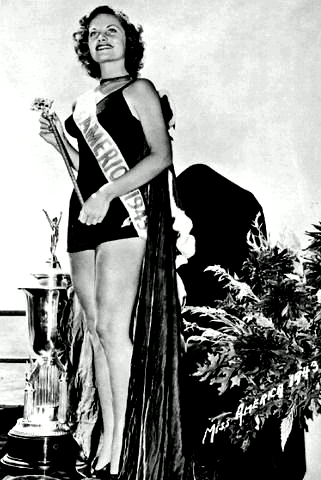
After the war, his daughter Else, married Alfred Leonhardt Bartelmeh, and in 1922, the family moved to America. They had a daughter, Jean who was born in Los Angeles 26th October 1923. Jean shortened her name to Jean Bartel. She later won the Miss America competition in 1943. Jean was the first college student to be crowned Miss America. She worked on Broadway as an actress/singer, and later worked in films and TV. Jean once claimed that “I was never beautiful, but I had vitality and looked healthy”. She married William Hogue but had no children. She died 6th March 2011 aged 87.
Sadly, her brother William, who became a doctor, was killed in an allied bomb attack in Germany in WW2.
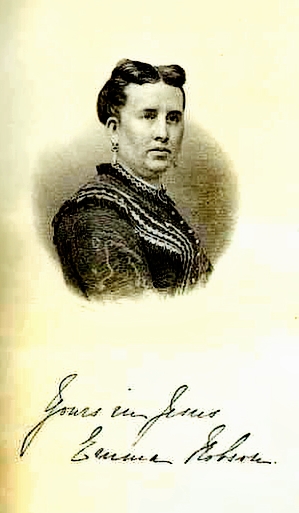
Emma Hodge was the eldest of the 6 children of Henry Hodge and his wife Jane (Simpson). She was born in Louth on 27th November 1837. Her father was working there, prior to his retuning to Hull to establish his own seed-crushing mill.
The family lived on Holderness Road, near Williamson Street. Emma became very involved with the Primitive Methodist movement through her father. He had donated large sums of money for the establishment of chapels in Hull. He was also a friend of William Clowes. Clowes was one of the co-founders of this religion.
She was an active member of the ‘Bright Street Chapel opposite the family home. This chapel was one which her father had laid the foundation stone. He had also donated substantial monies for its construction in 1863.
Emma married Joseph T Robson (1838-1897) at the William Clowes Chapel in Jarratt Street on 26th May 1859. Joseph was a manager at her father’s mill on Holderness Road. He was also an active member of the Primitive Methodist Church.
Emma, (referred to as Mrs JT Robson), and her husband, were well respected, and regularly preached at local chapels. She also became a councillor, a rare event in Victorian England.
They moved to a house in Hornsea Parade on Holderness Road. During their marriage they had 3 children. These were Henry Hodge (1860), Edwin (1863) and William Arthur (1865),
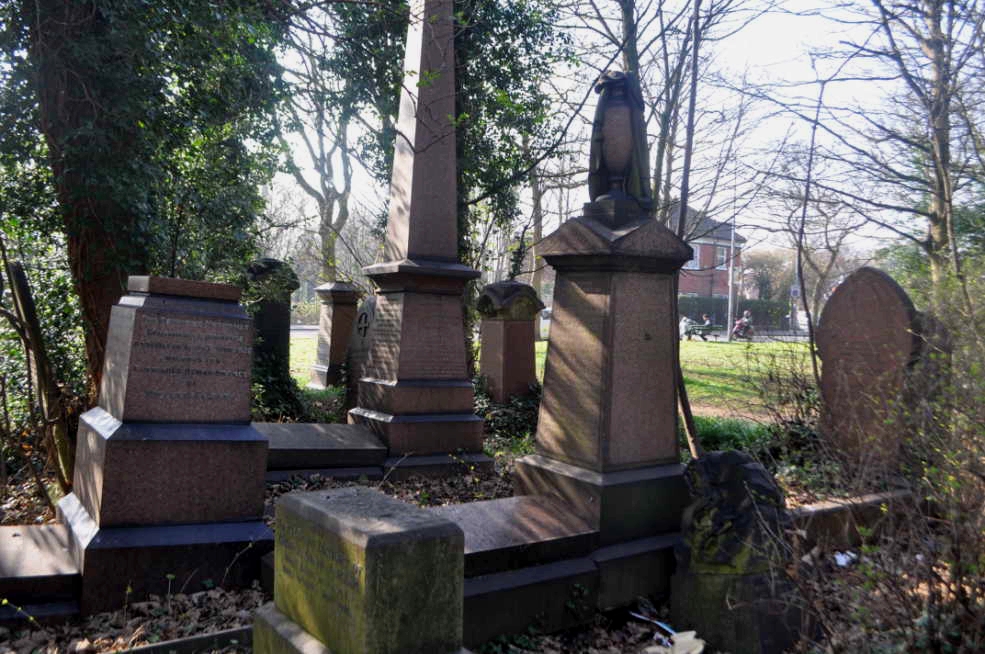
Emma died from Erysipelas, (an acute skin disease), on 30/6/1869 aged just 31. Her father was devastated by her death, and erected a large monument in the ‘Prim Corner’ section of HGC. The Reverend Joseph Wood wrote a rather morose book about her, entitled ‘Sunset at Noonday’. The 1870 ‘Primitive Methodist Magazine’ published Emma’s obituary. In it it is stated that ‘she was as near our ideal of the model wife and mother’.
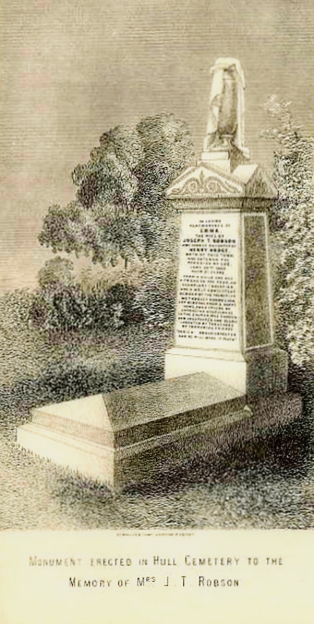
Her husband remarried Ellen Mallinson in 1873, and had 2 further children. He died in 1897 aged 59 and is also buried in the same grave as Emma.
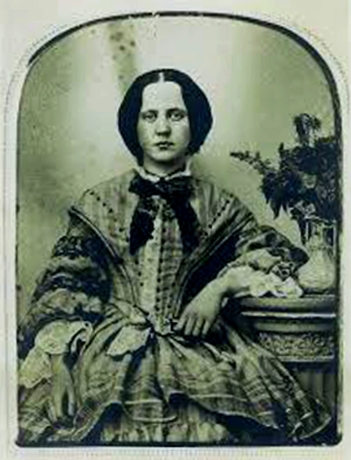
Rebecca was the grand-daughter of William Irving, (the eldest daughter of Jane 1812-1860), and her husband John Richardson Greenwood (1806-1874), the son of a Hull shipping merchant. She was born in Hull on 8 April 1837. She was baptised at the Fish Street Independent Church on 22 June, 1837. The family moved to Dollar in Scotland, and later to Crosby Garrett. This was on the edges of the Lake District. Rebecca spent her teenage years here. Her paternal grandfather, George Greenwood, was a lay Baptist preacher who lived in Haworth. He was also a friend of Patrick Bronte. During the family’s visits to Haworth, Rebecca became friends of the Bronte sisters.
The family emigrated to Australia in 1858, unaccountably, leaving their youngest son (Rebecca’s brother), William Irving Greenwood in Hull with her parents William & Mary Irving. Was it because he was a sickly child? We don’t know. He died of scarlet fever, in 1862 however aged only 11. He is buried in the family grave in Hull General Cemetery.
After the family emigrated to Australia, Rebecca married George Morrison M.A., after her family emigrated to Australia. He was the Principal of the National Grammar School, Geelong, in Melbourne. He was made the Principal on 7th December 1859. They had nine children. Rebecca helped run, and expand the Geelong College with her husband.
Rebecca Morrison played an important, though little advertised role, in the evolution of the Geelong College. Known simply as ‘Mrs Morrison’ to generations of students. She guided the boarding and domestic establishment that underpinned the operations of the School.
One ex-student wrote, “She always took a vivid interest in the boys at the College, and her marvellous memory for names and faces lent a great deal of charm to the visits of old boys, who came back expecting to find themselves forgotten, only to learn that Mrs Morrison remembered them and many little incidents of their school careers”.
After the death of her husband in 1898, Rebecca continued be involved with the college. The Morrisons were to have eight children – five sons and three daughters. Rebecca died at South Yarra on 26 March 1932 aged 94 – three of her sons; Charles Norman, George Ernest, and Arthur Robertson Morrison having predeceased her. Geelong College still exists and continues to flourish.

Sarah Smith was born in Hull in 1758, the daughter of Joseph Smith. She was baptised in Holy Trinity Church on the 31st August 1758. She also had a sister who was 10 years her junior called Mary, (Polly).
Sarah married mariner, William Robinson in Holy Trinity on 13th September 1785. She was obviously educated, as she signed her marriage certificate.
Sarah took on the post of Matron and House keeper of Trinity House on Christmas Day, 1794. In addition to providing lighthouses, charts etc, Trinity House were also trustees to a fund for relief & support of all maimed and disabled seamen, their widows, and children.
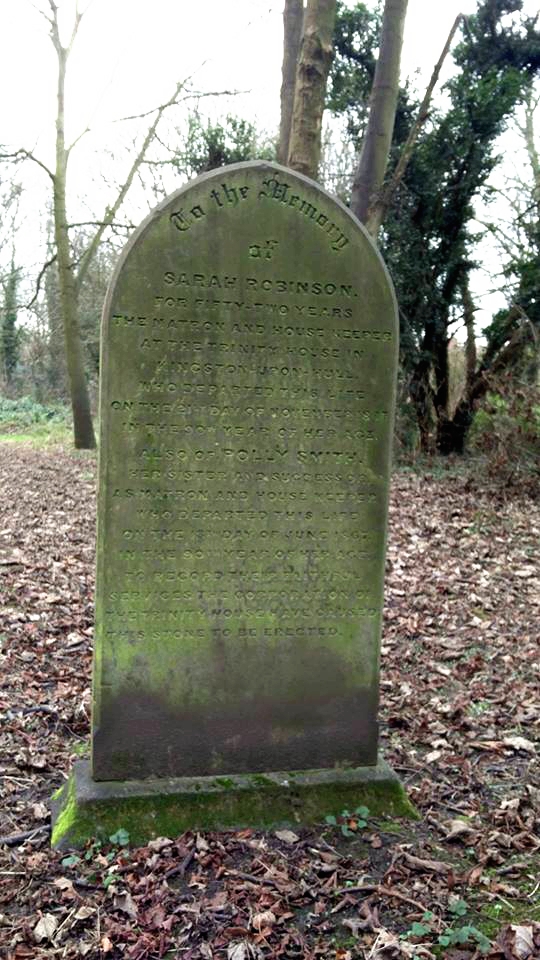
Remarkably, Sarah stayed in the post for 52 years, until her death on 21st November 1847 aged 90. She was succeeded in the post by her unmarried sister, Polly. She remained in the post for a further 10 years, until her own death in 1867, also aged 90.
Trinity House were obviously very impressed with the service of Sarah and her sister, Polly. “To record their faithful services the Corporation of The Trinity House have caused this stone to be erected.” The headstone still remains.
Sarah was buried in the same year that Hull General Cemetery opened. She was the 137th person to be buried there. A remarkable epitaph to two remarkable women.

Bill Longbone has had a long relationship with the Hull General Cemetery. He is an active member of the FOHGC and manages the work of the volunteers on the site. His biographical sketches of some of the people buried in the cemetery are one of the highpoints of the success of the Facebook site.
William Tesseyman was termed as Hull’s oldest businessmen in his obituary in 1919. He died at the age of 91 whilst still working.
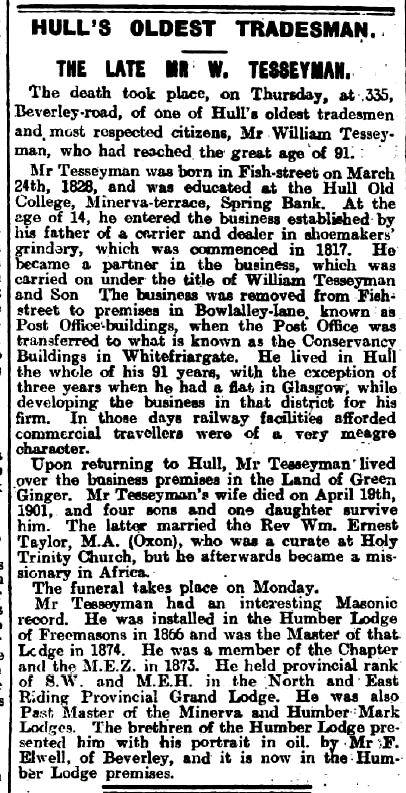
William Tesseyman was born in Fish Street, Hull in 1828. He was the eldest child of George and Mary Ann Tesseyman. He worked as a currier (leather curer) in his father’s business that his father had started in 1817. The family business premises were initially on Bowlalley Lane, but later transferred to The Land of Green Ginger, at its junction with Manor Street.

William married Elizabeth Sarah Hart in 1851. The new family lived at Ocean Place. This was situated at the beginning of Anlaby Rd. They were living there with their 7 children. Sadly, two of them died in childhood, Alice, aged 4 months in 1865, and Elizabeth, aged 6 years, in 1866.

He was an active member of the Hull Masons, and became a Worshipful Master of the Humber Lodge. In the 1870’s, after the death of his father in 1871, the family moved to 335. Beverley Road. A public house called The Bevvy Hotel now occupies the site.
William’s wife died aged 68 in 1901 and he died in 1919. William, his wife Elizabeth and their two daughters are buried in Hull General Cemetery, along with other members of the family.
The business continued under the leadership of his sons.
The family headstone no longer exists. The East Yorkshire Family History Society recorded the inscriptions on the headstone.
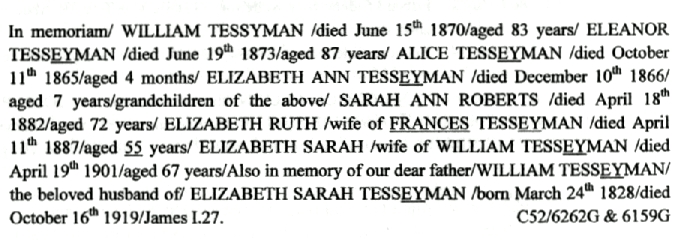

Bill Longbone has had a long relationship with the Hull General Cemetery. He is an active member of the FOHGC and manages the work of the volunteers on the site. His biographical sketches of some of the people buried in the cemetery are one of the highpoints of the success of the Facebook site.